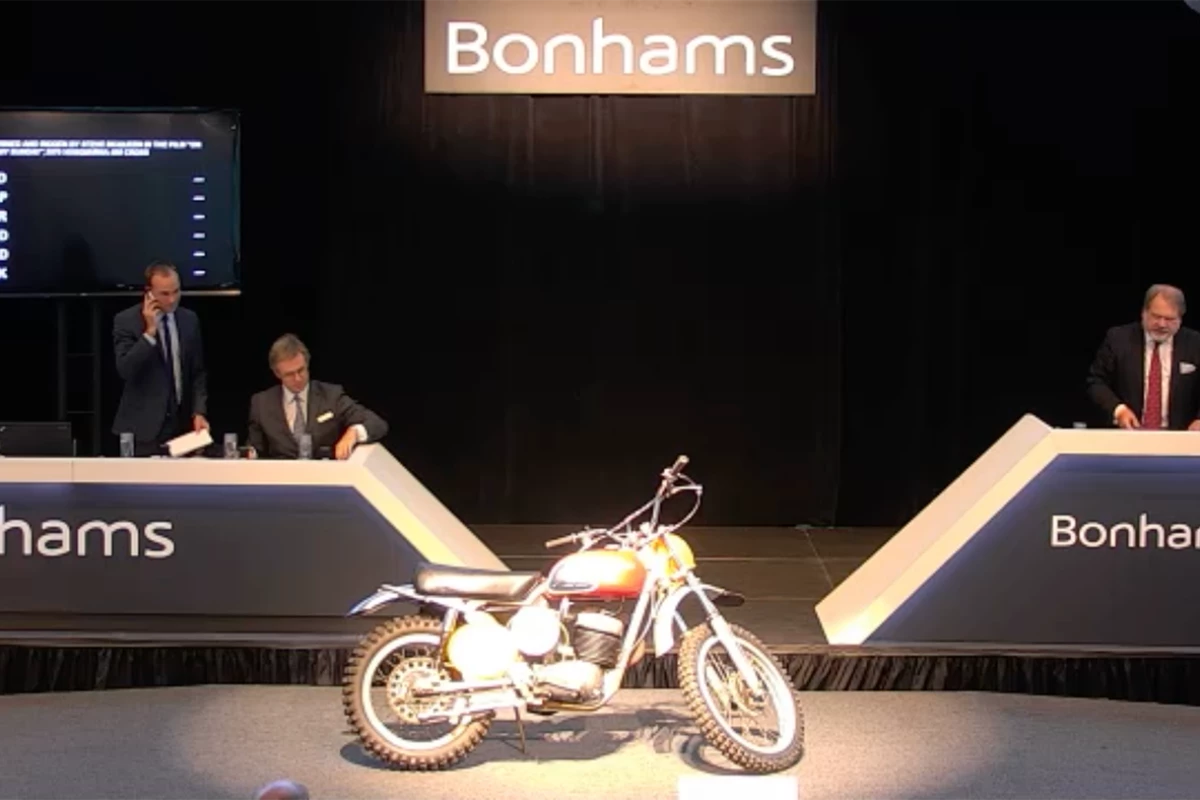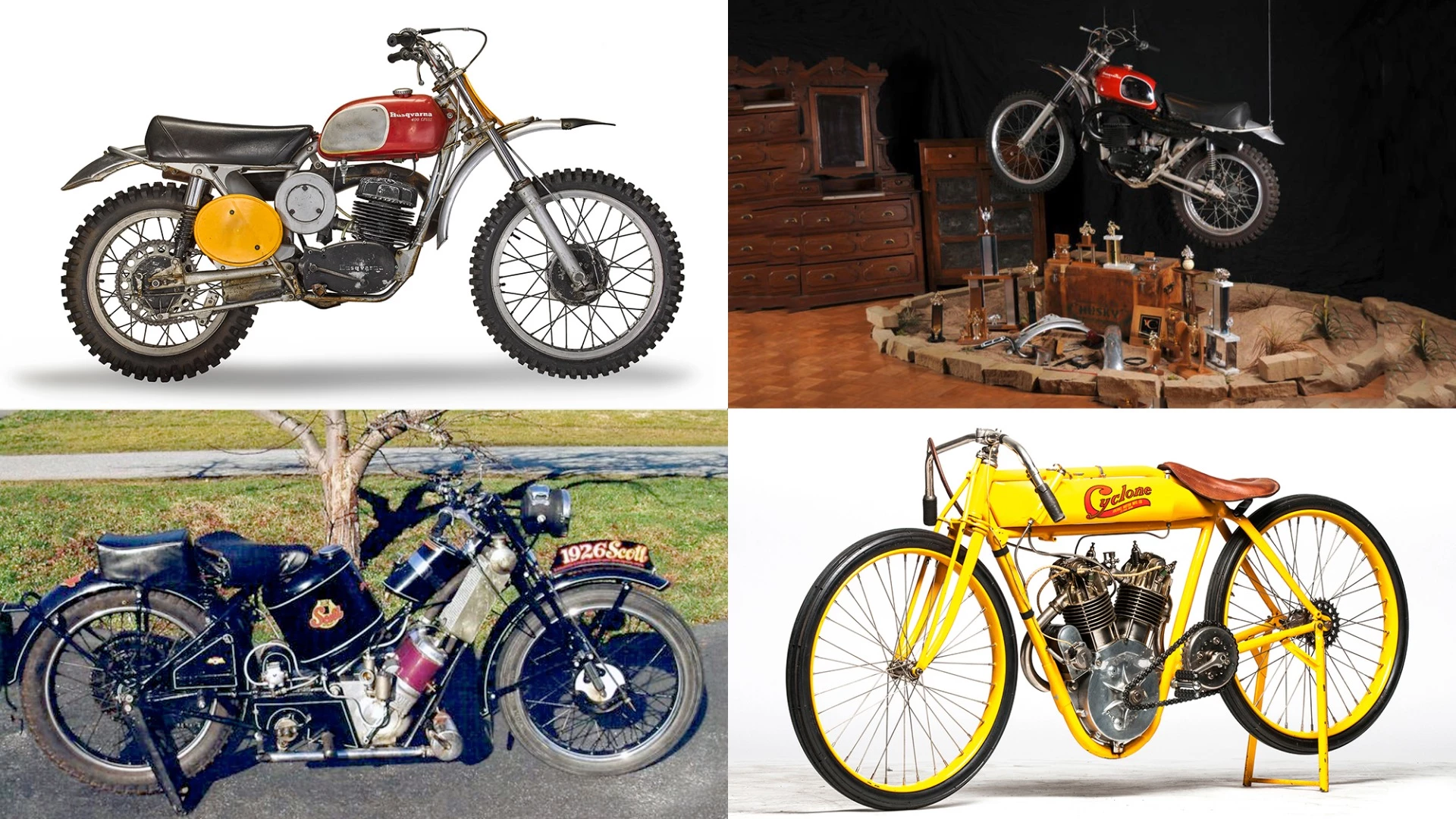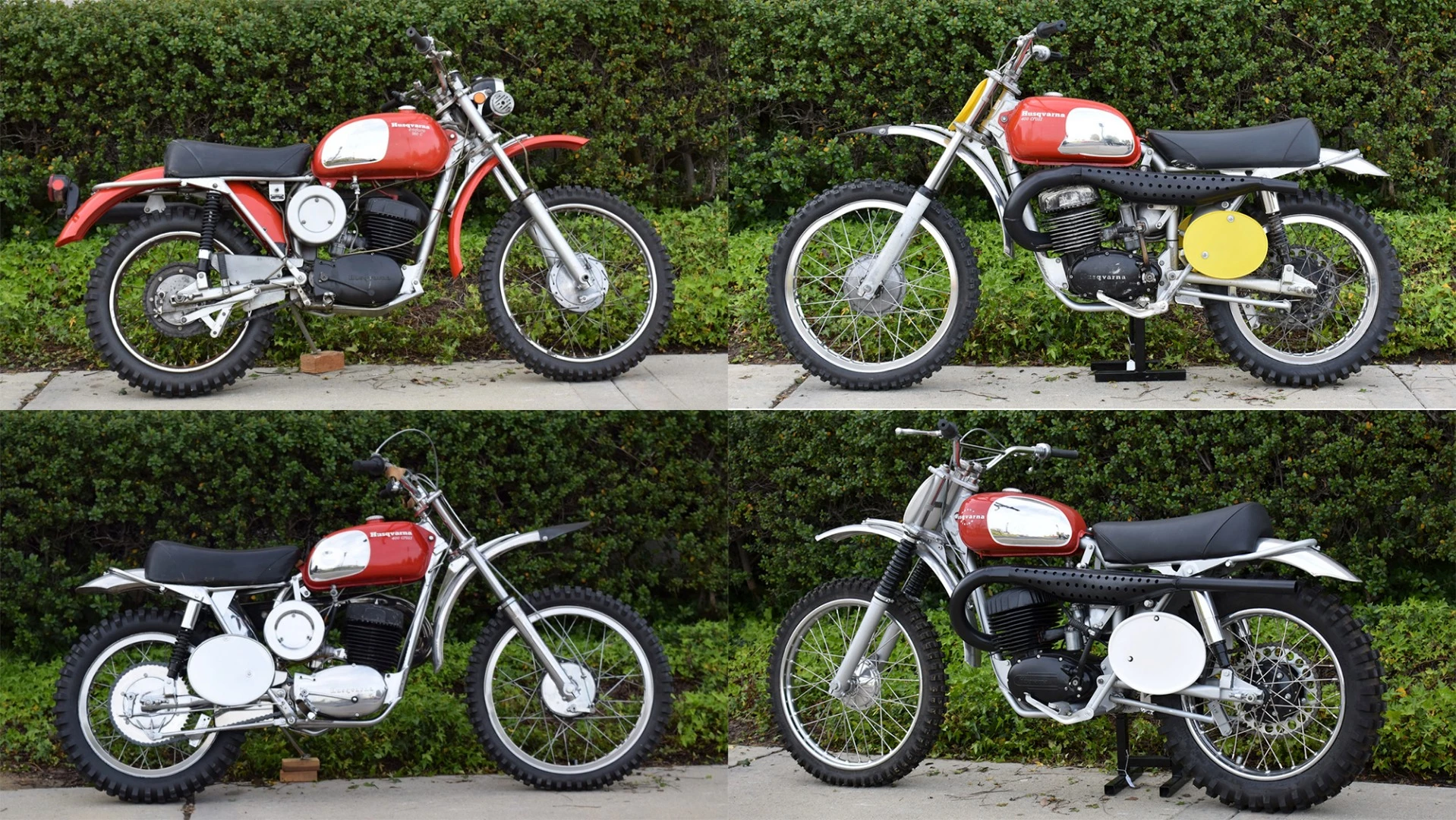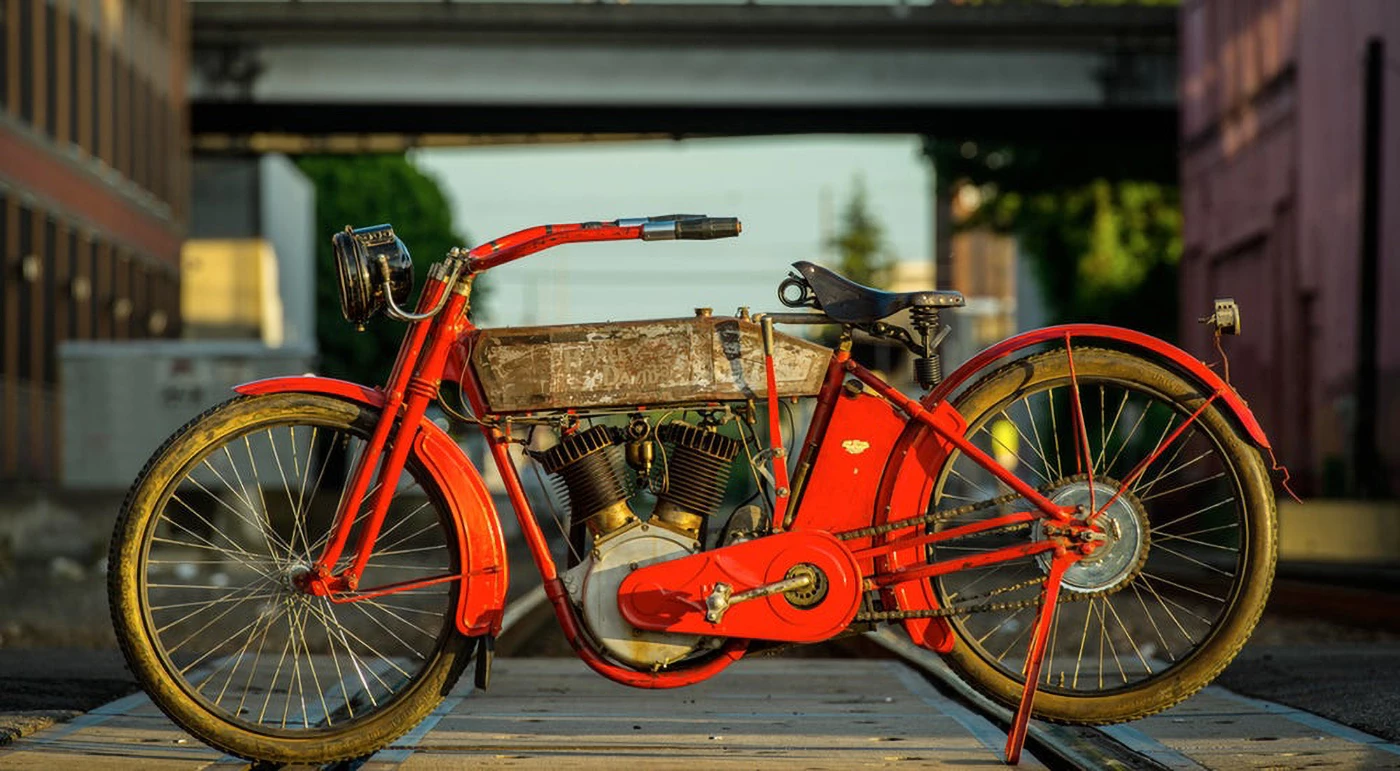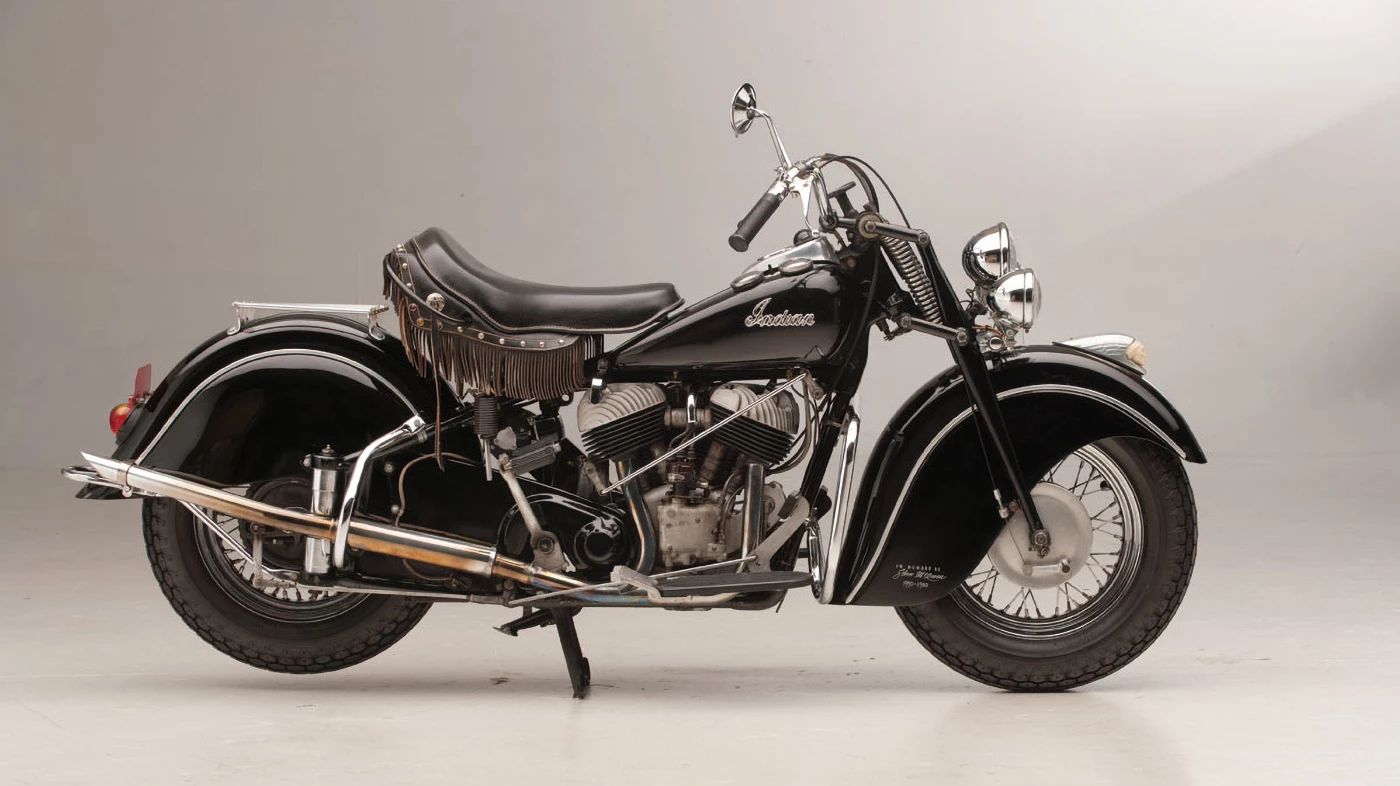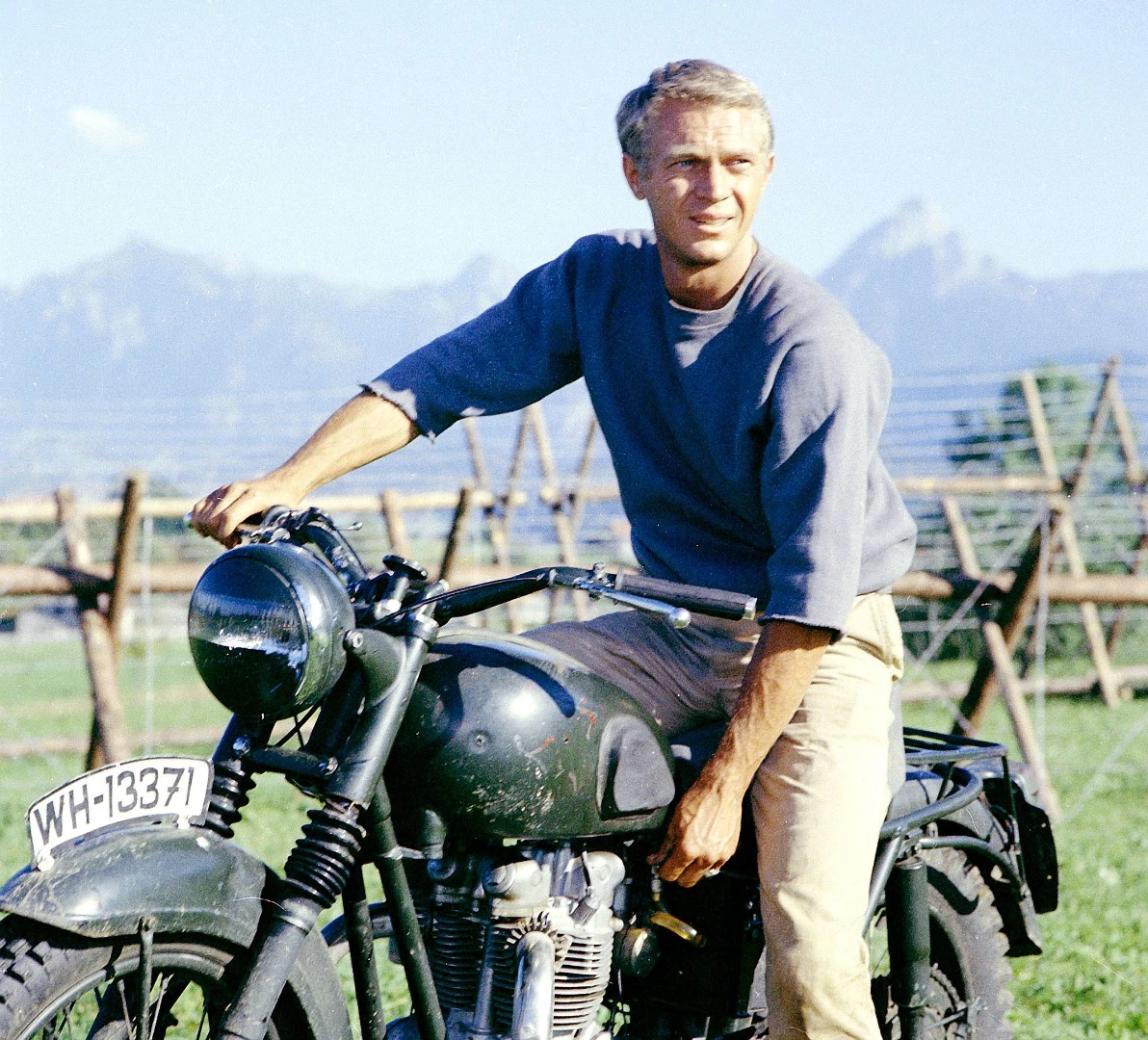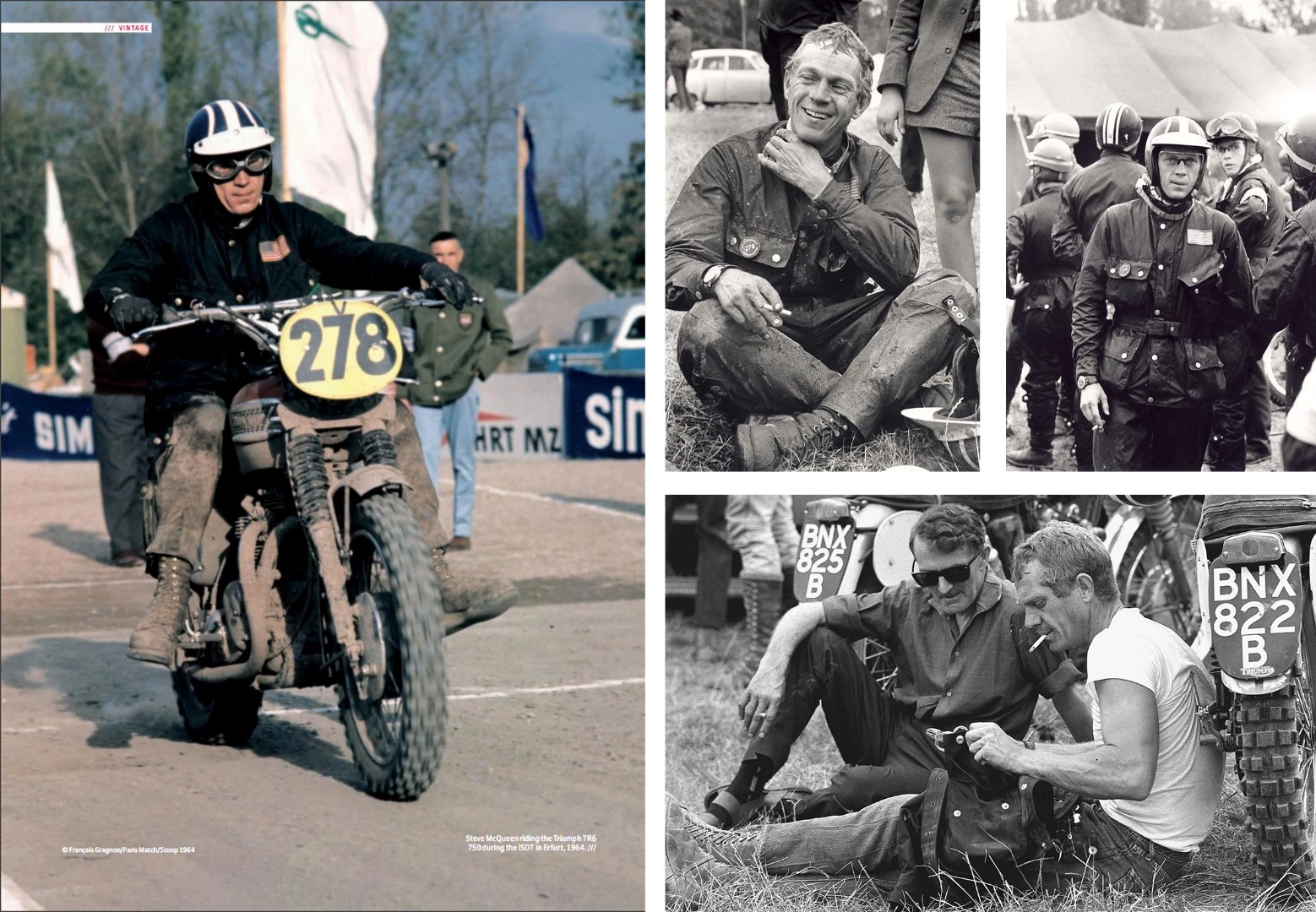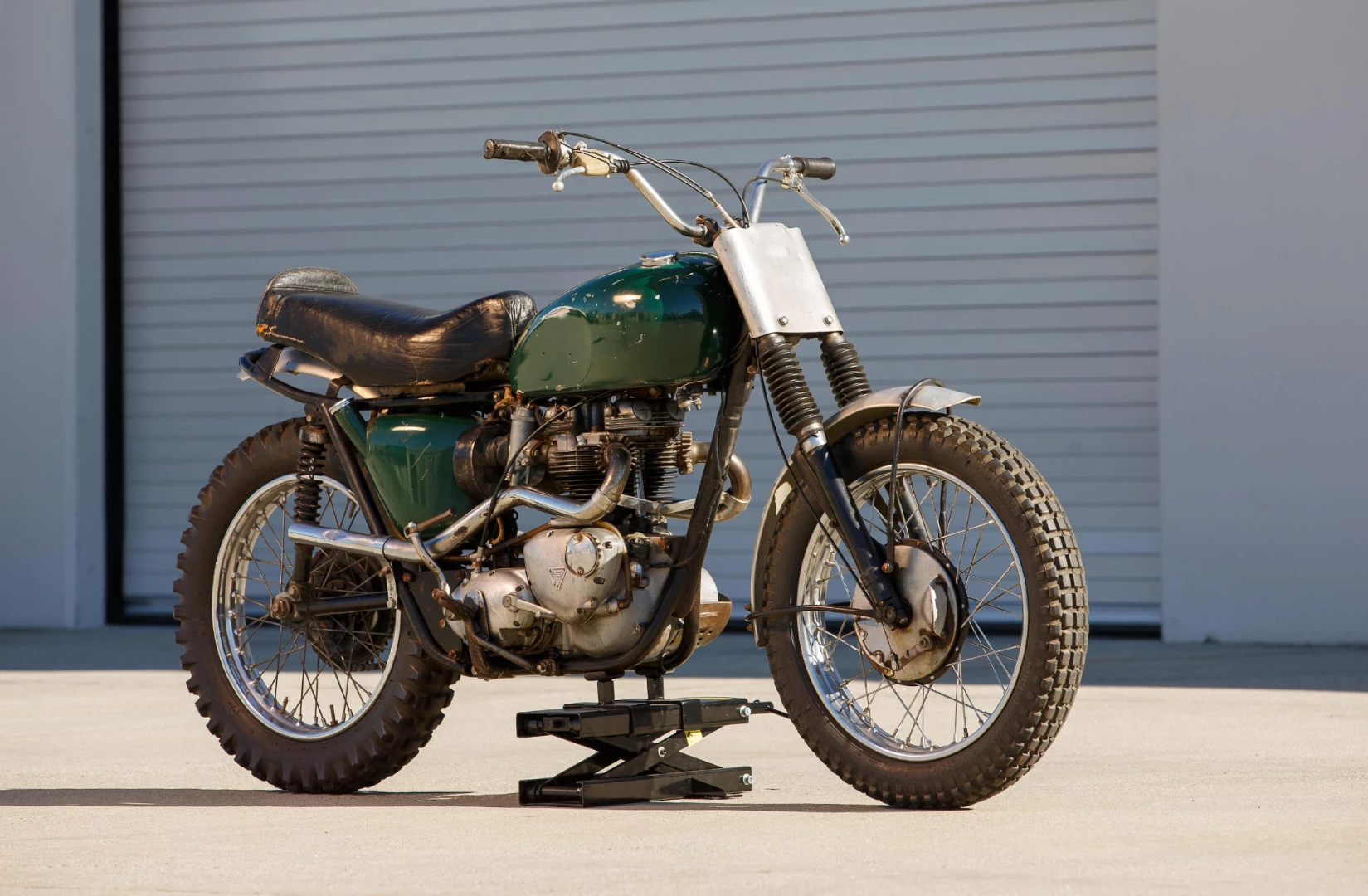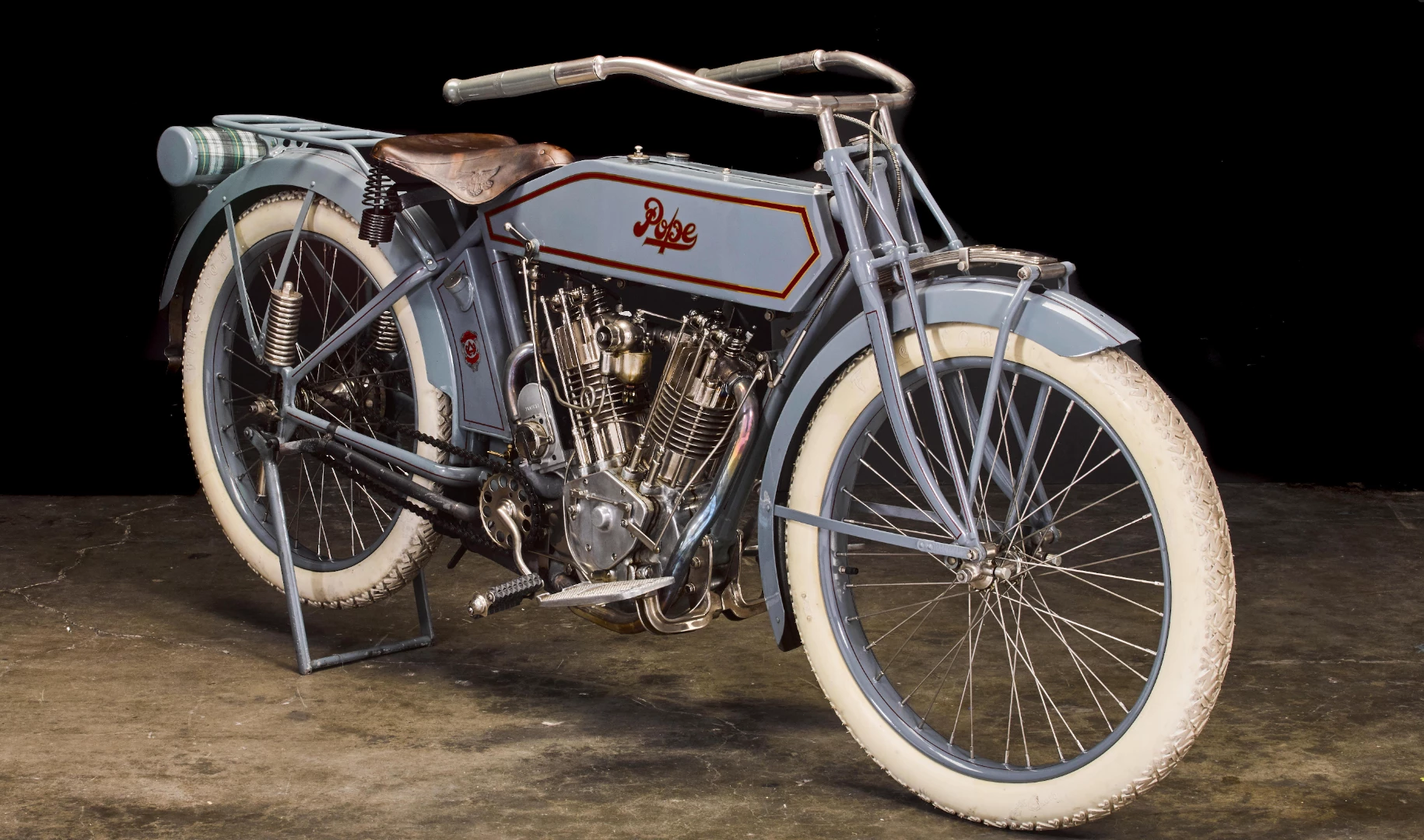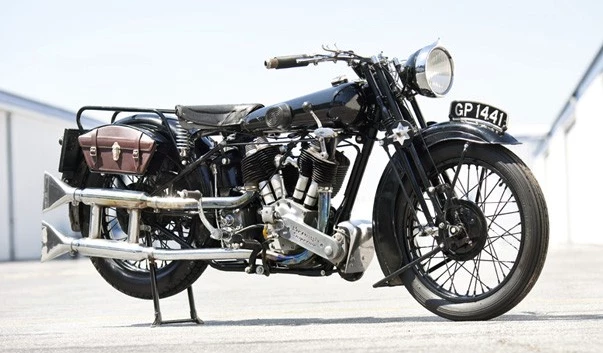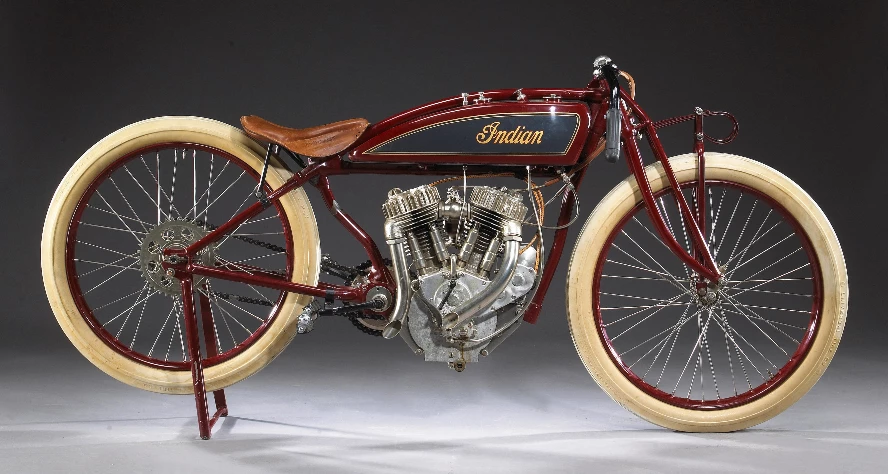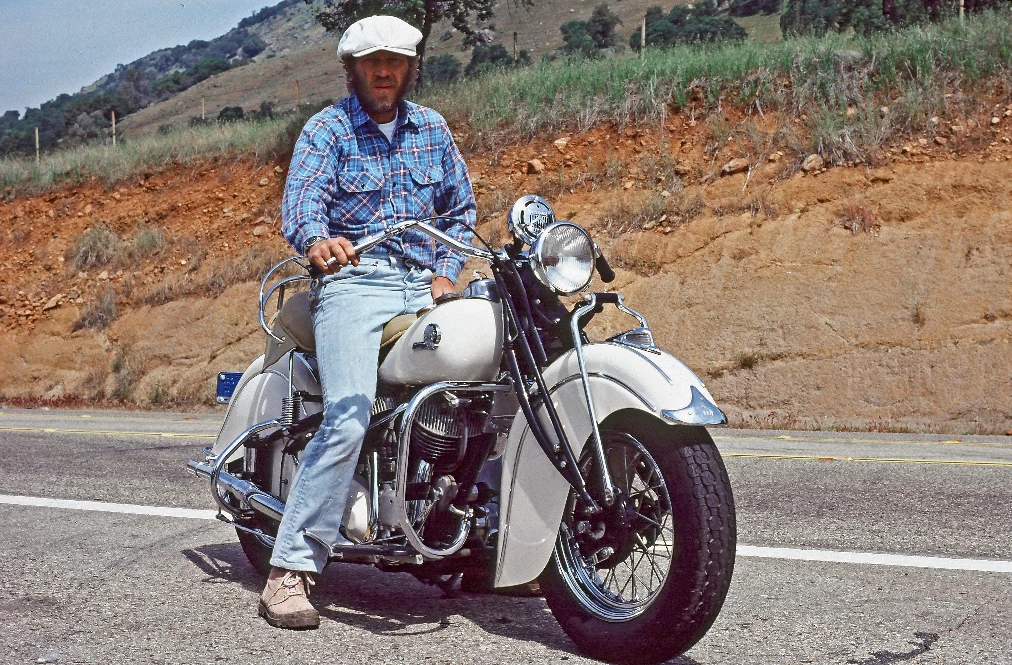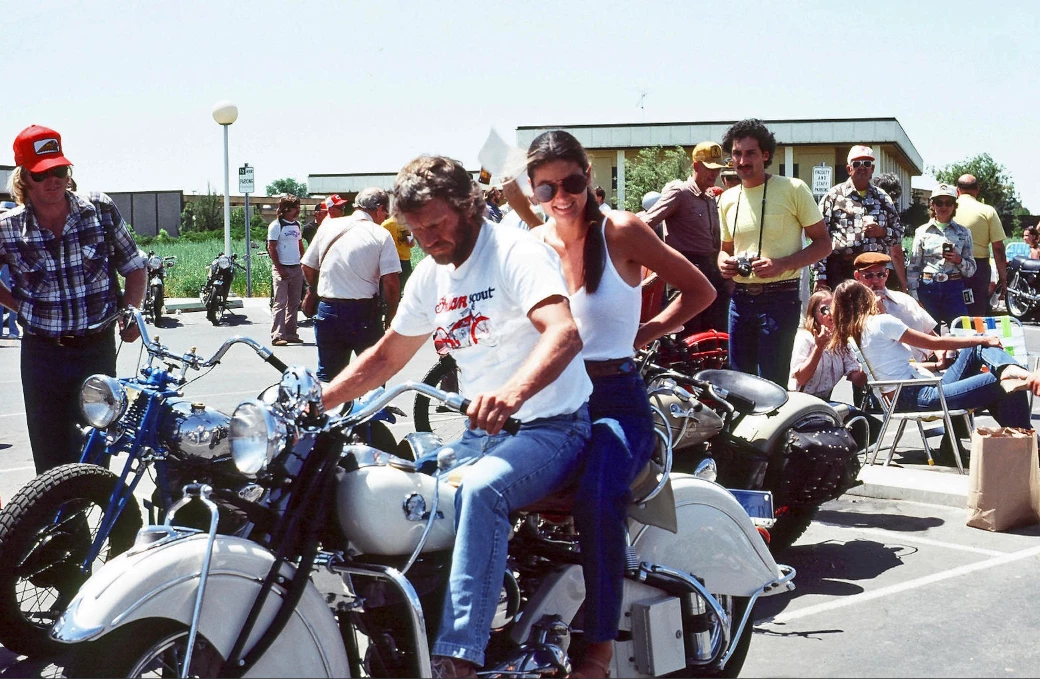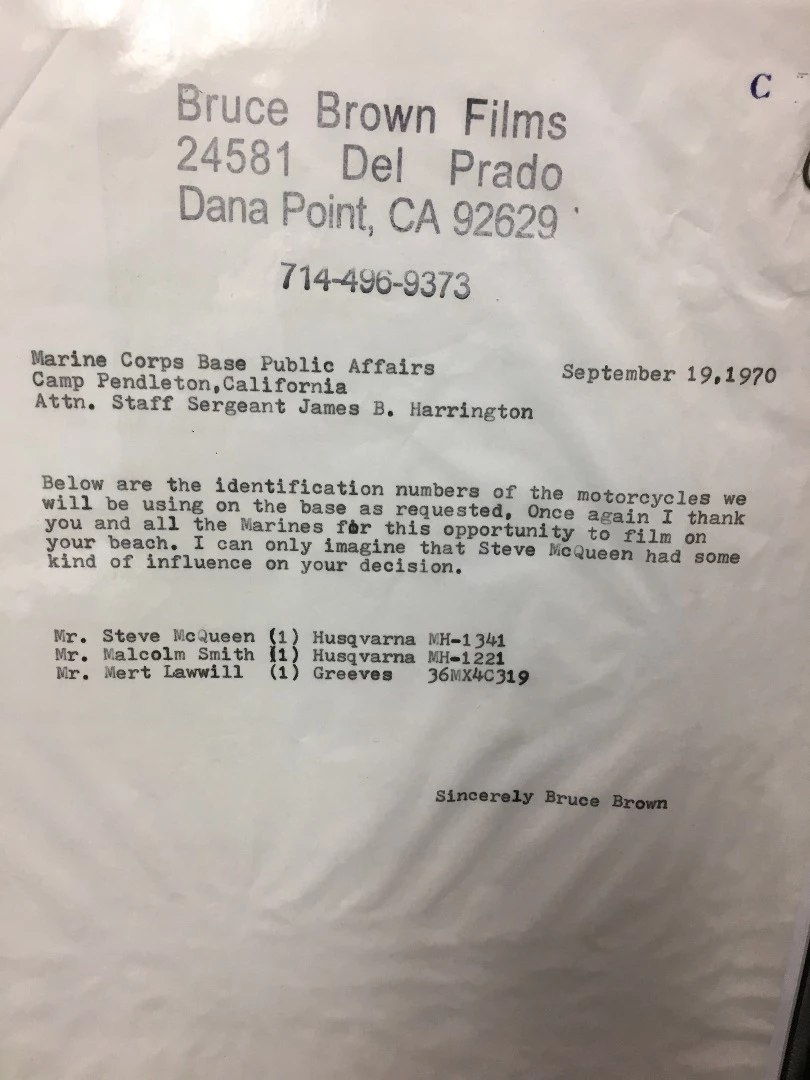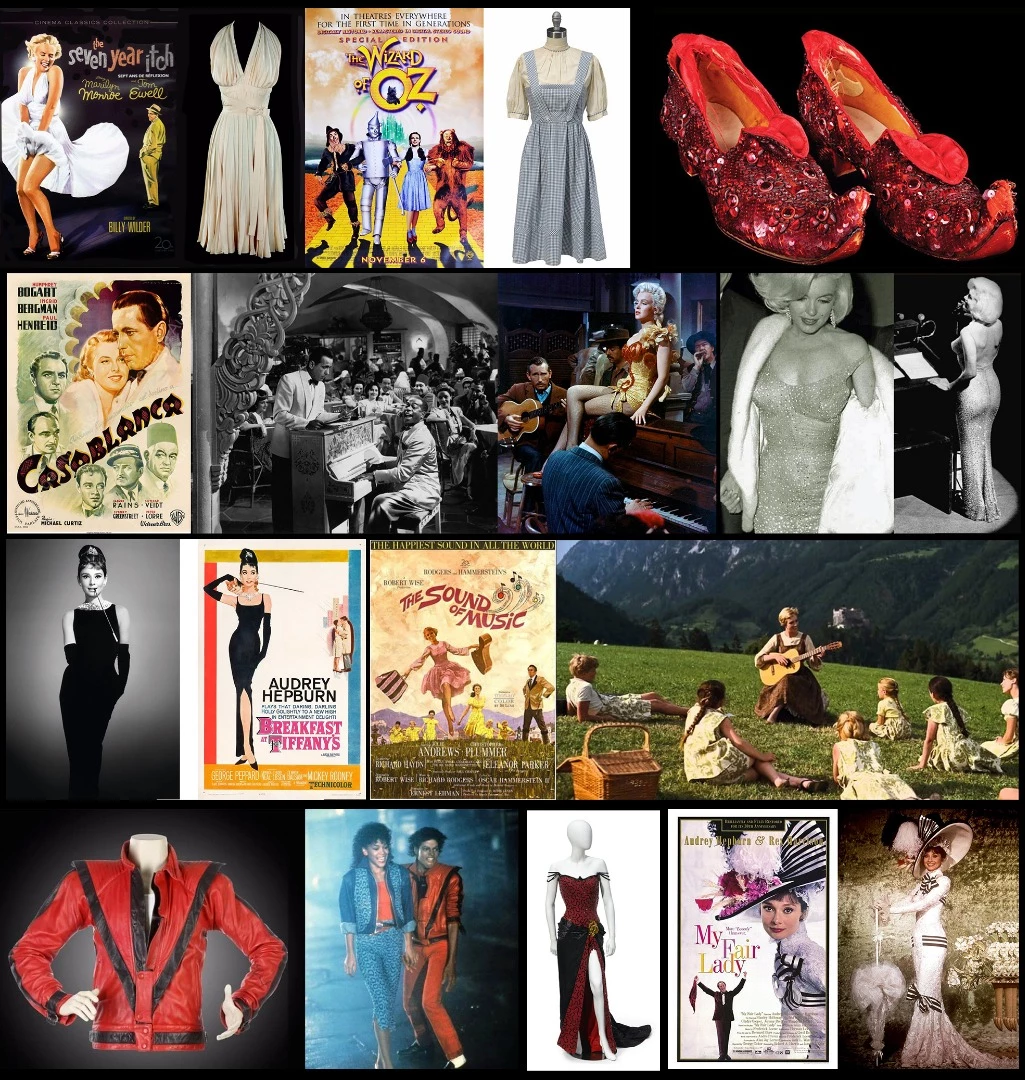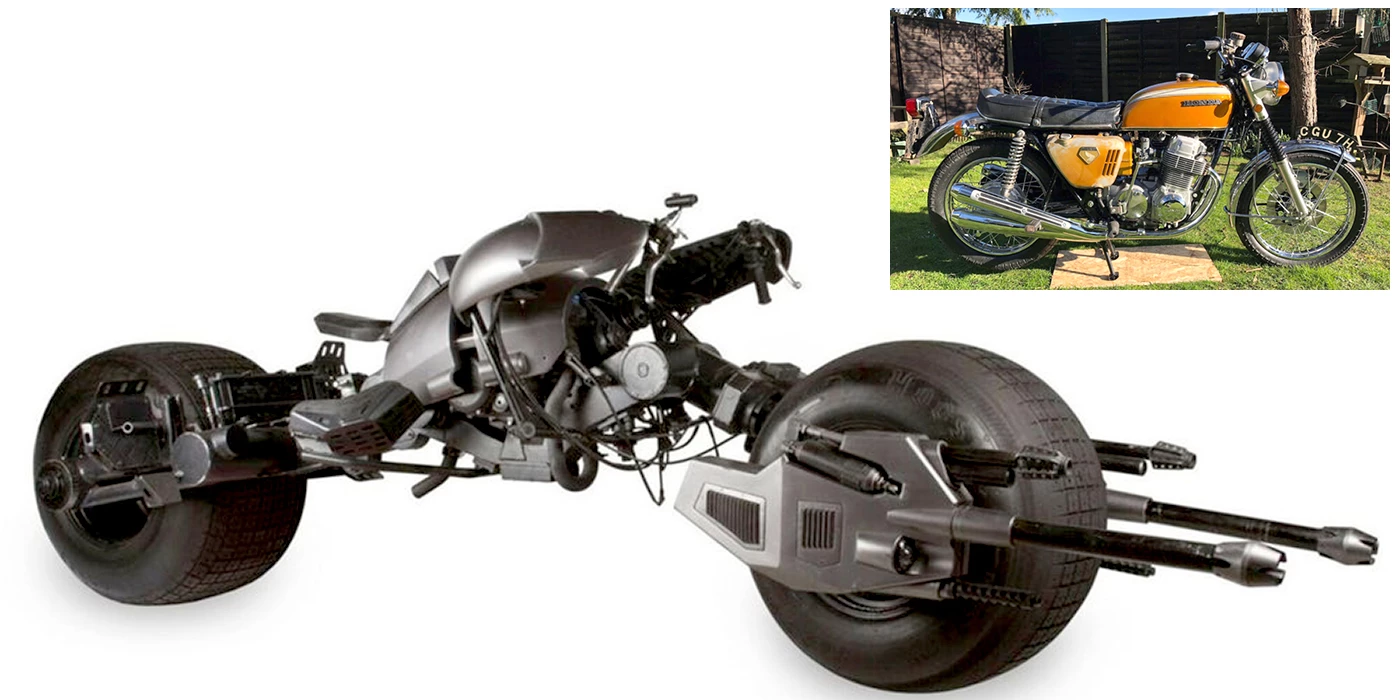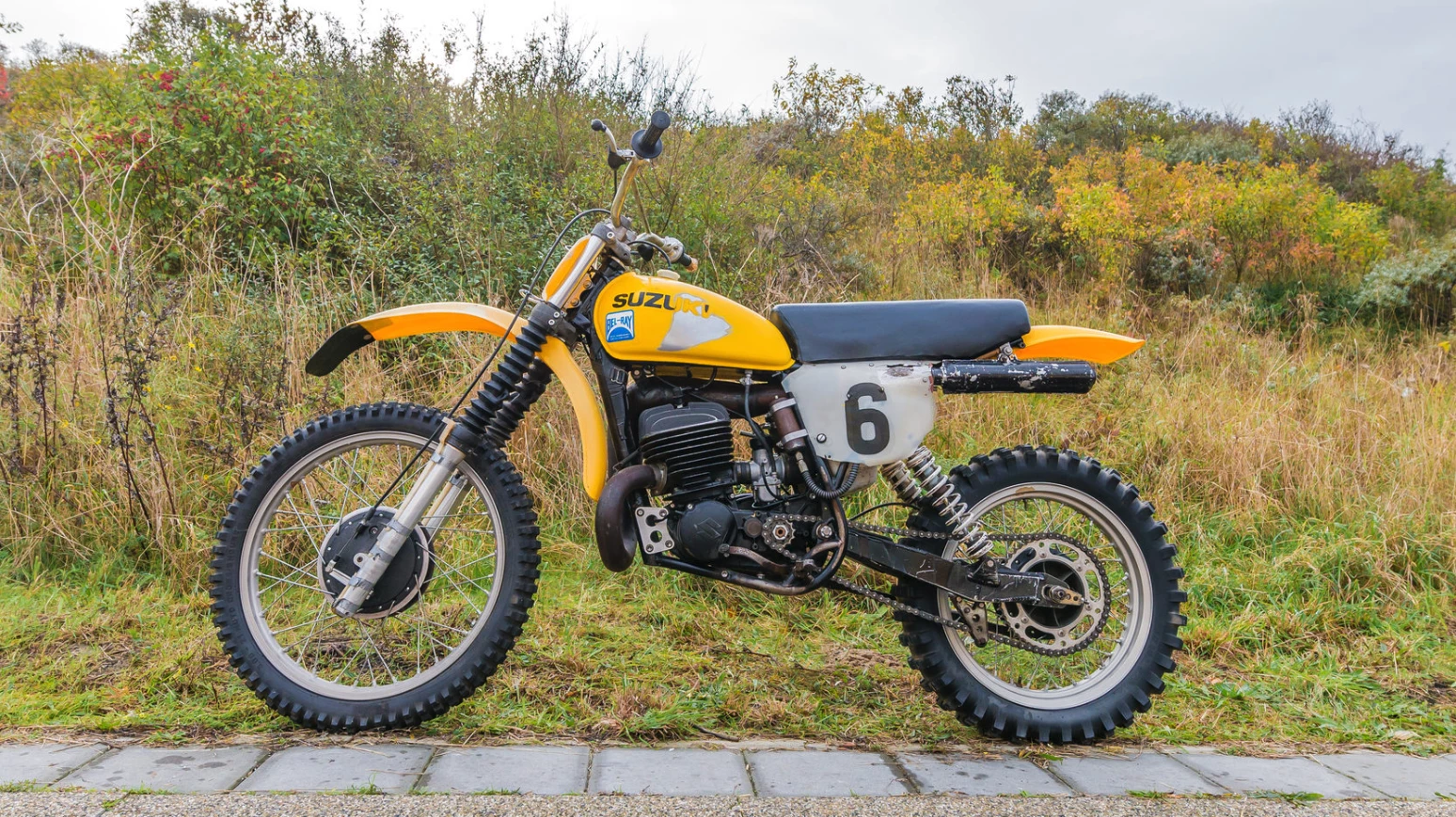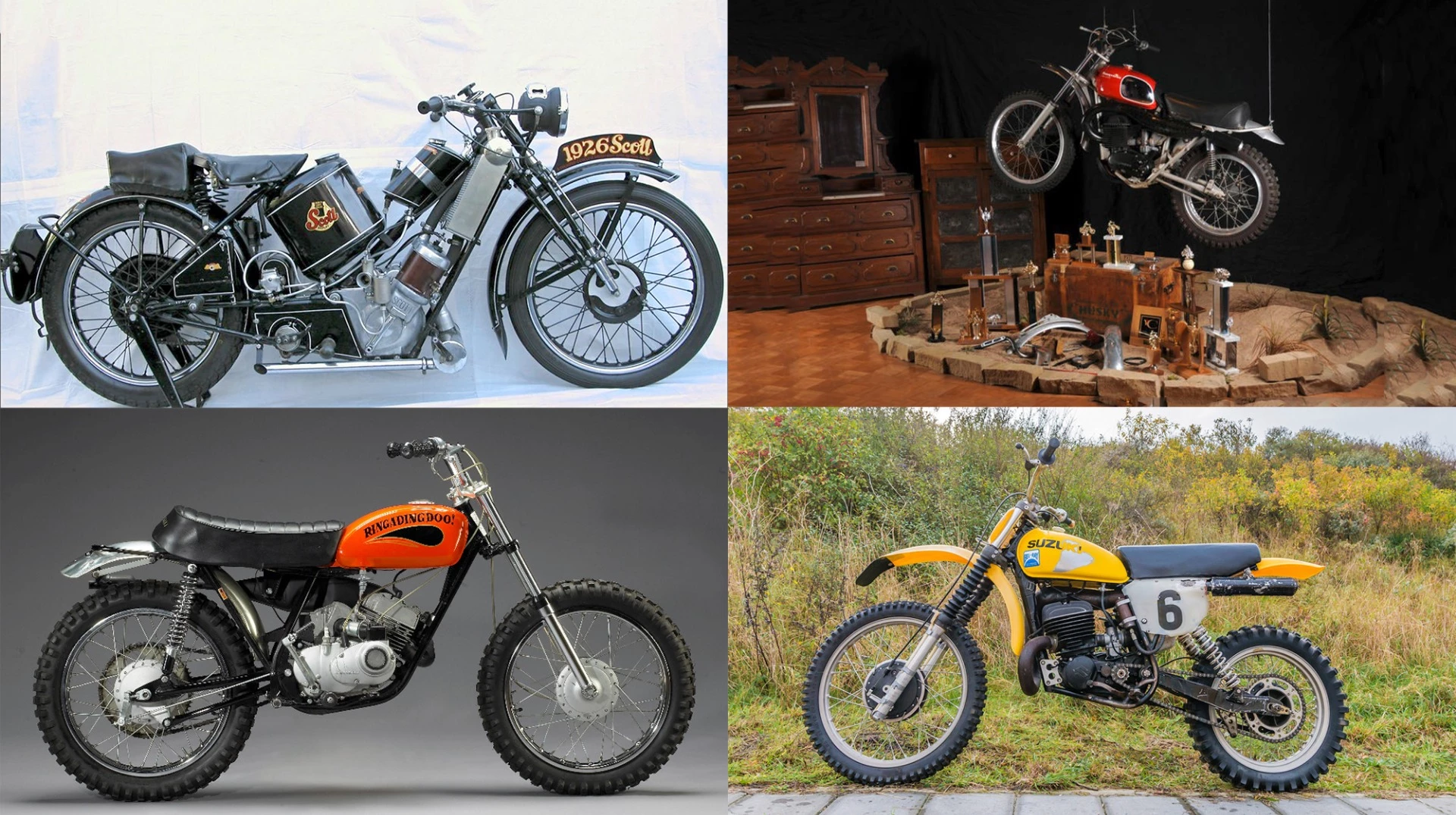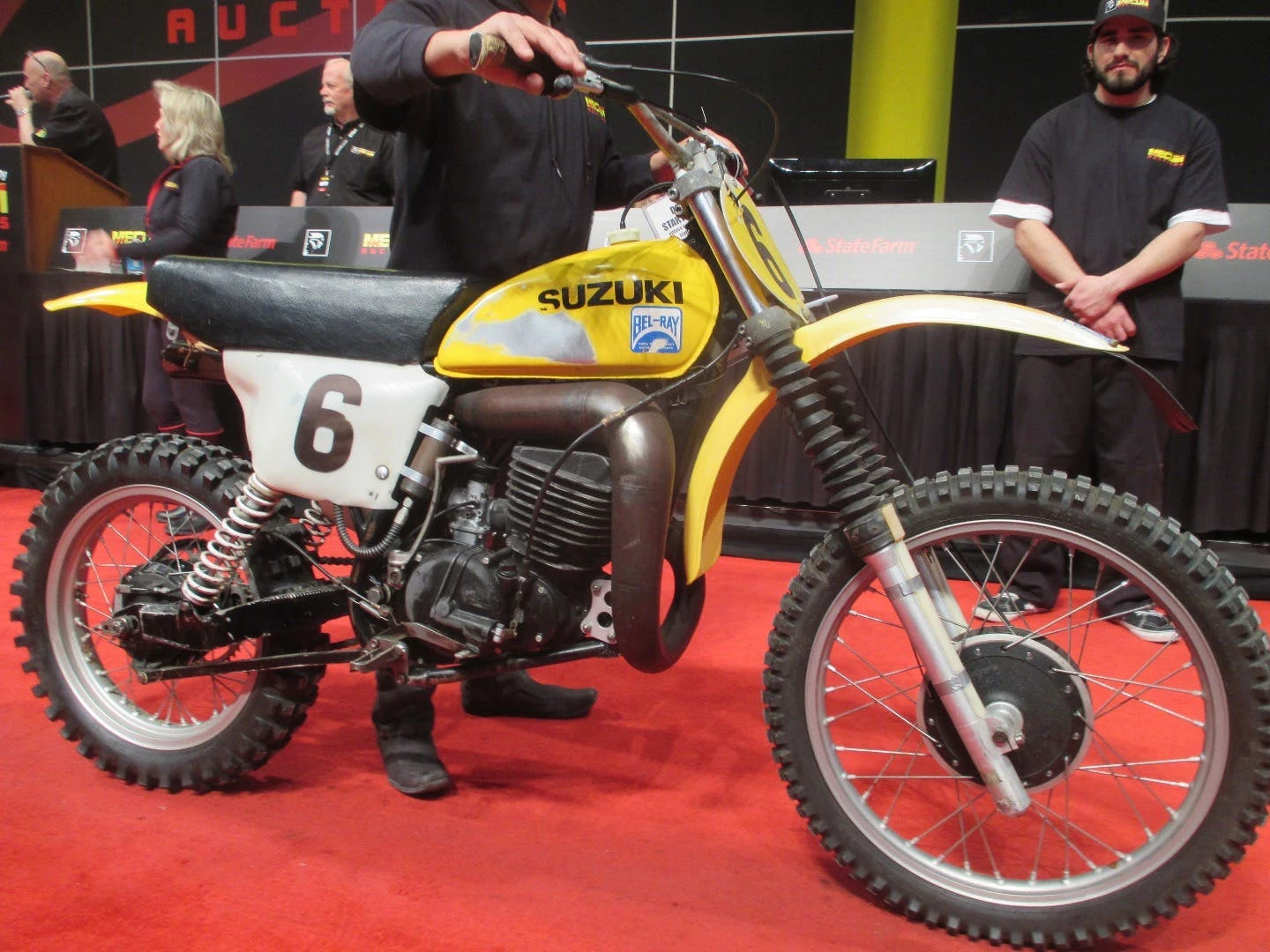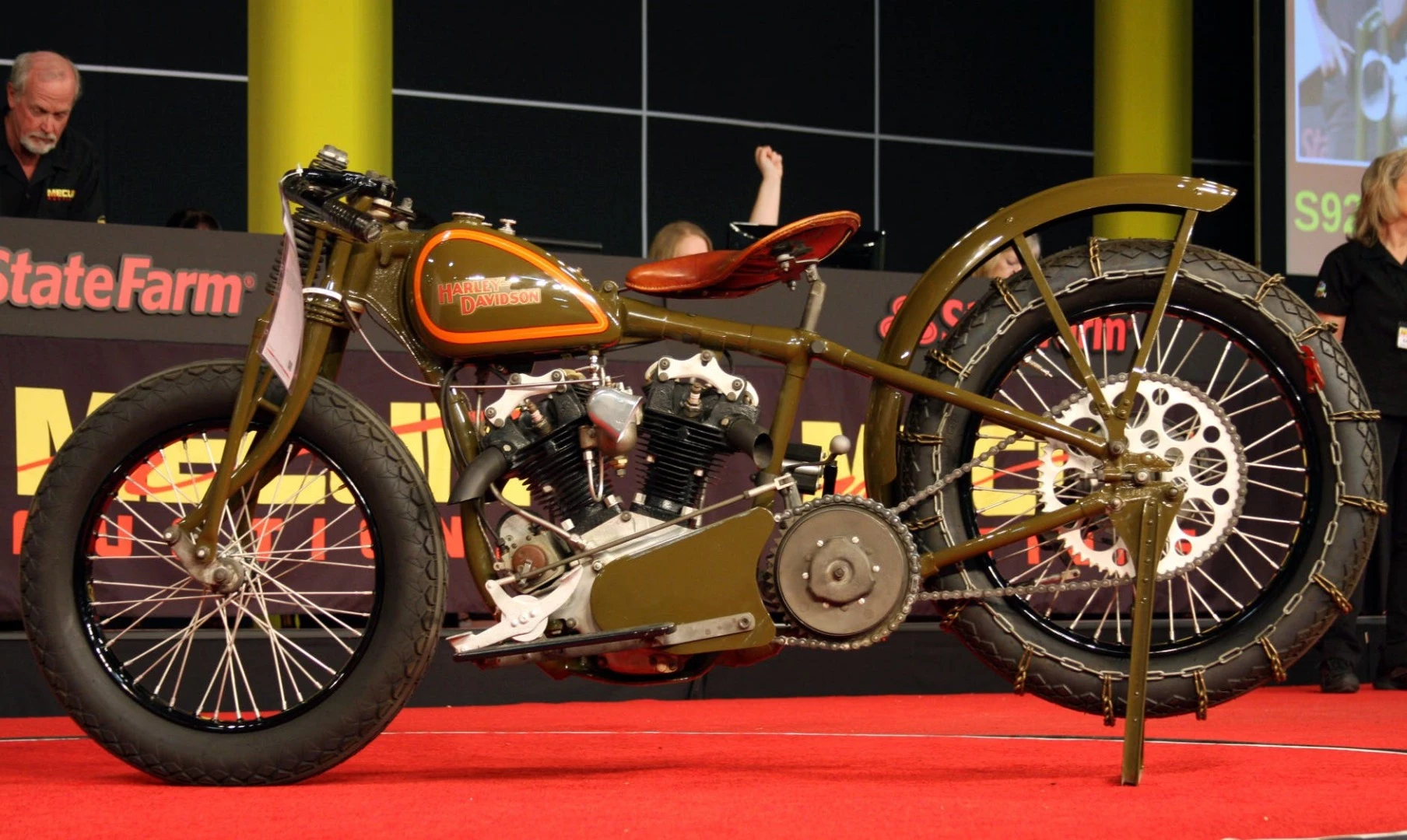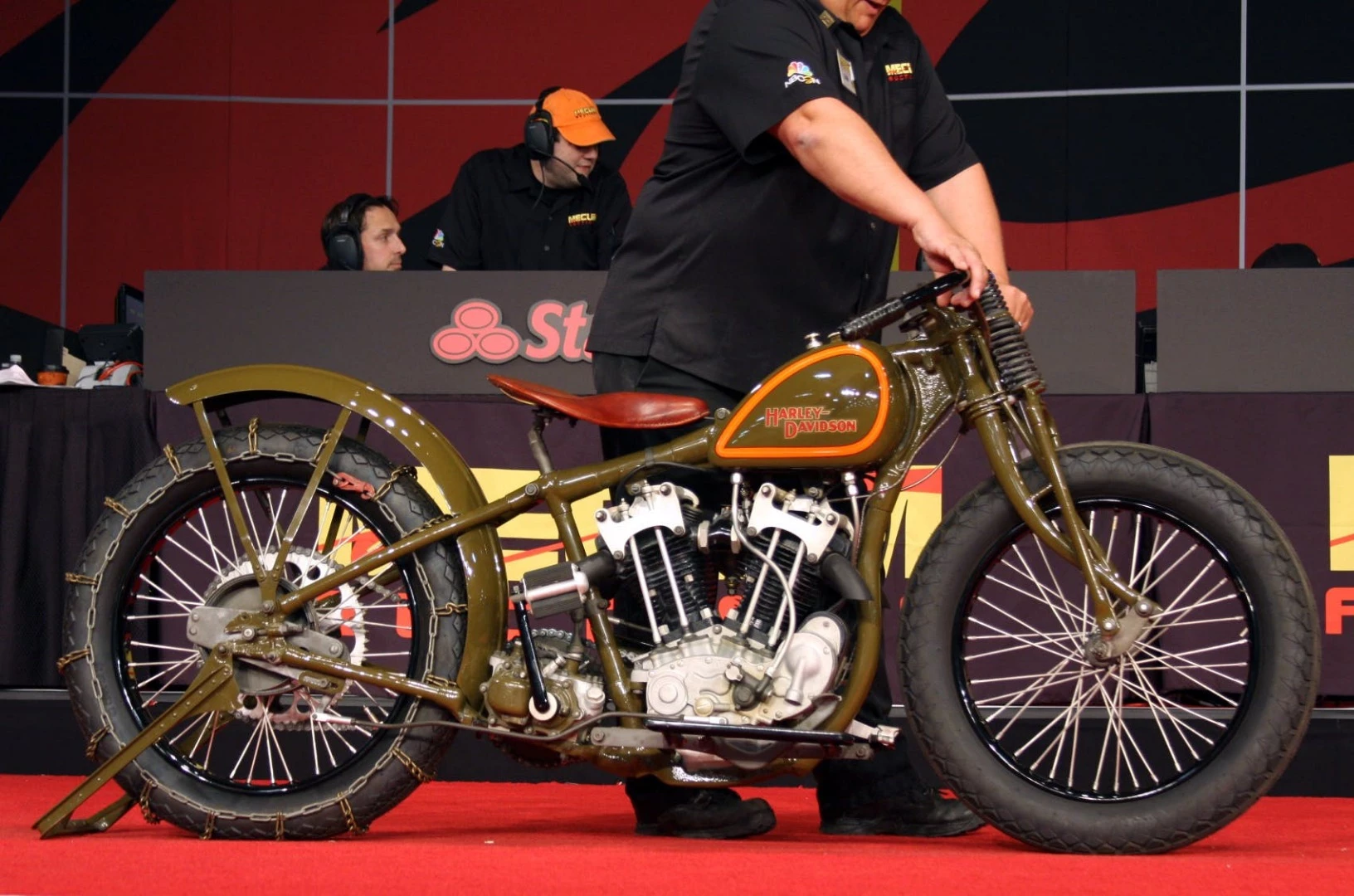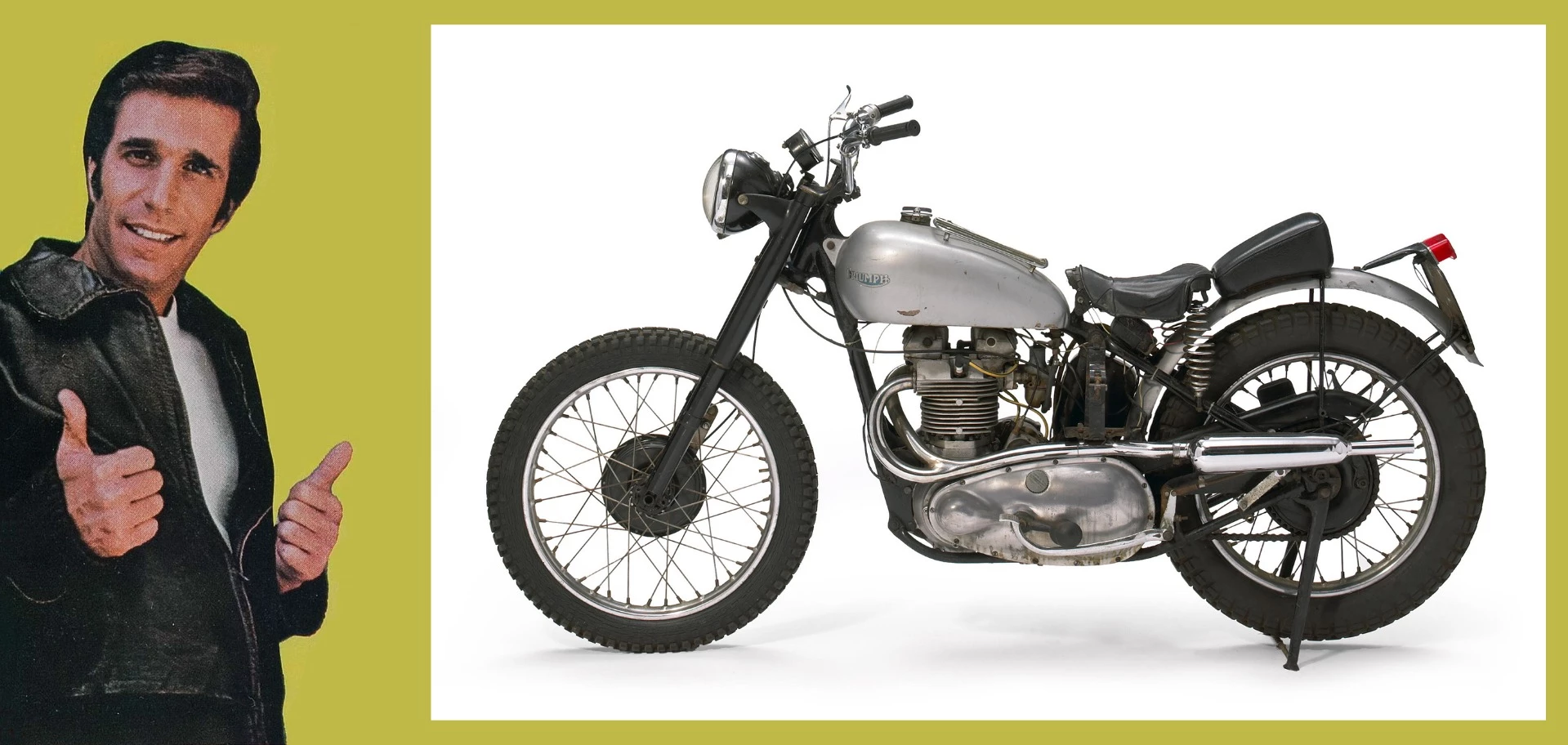Steve McQueen's most famous motorcycle, the 1970 Husqvarna 400 Cross he rode during Bruce Brown's 1970 feel-good motorcycle movie, On Any Sunday, sold at auction on the weekend for $230,500.
This is the story of how this bike sold for $1500 in 2008 without anyone knowing it had been owned by the world's highest paid actor, then went to auction five years ago with the McQueen connection proven, yet couldn't meet its $80,000 reserve price.
This time though, the bike went to auction with irrefutable evidence that it was the motorcycle ridden by McQueen in the cult movie, On Any Sunday, and the records tumbled.
Fetching $230,500 at Bonhams Barber Museum Sale on October 6, 2018, the 400cc two-stroke single became the most expensive Husqvarna ever sold (previously another ex-McQueen 400 Cross at $144,500), the most expensive motocross bike ever sold (the same bike - $144,500), the most expensive dirt bike ever sold (previous record $181,500 for a 1930 Harley-Davidson Factory DAH hillclimber), and the second most expensive two-stroke motorcycle ever sold.
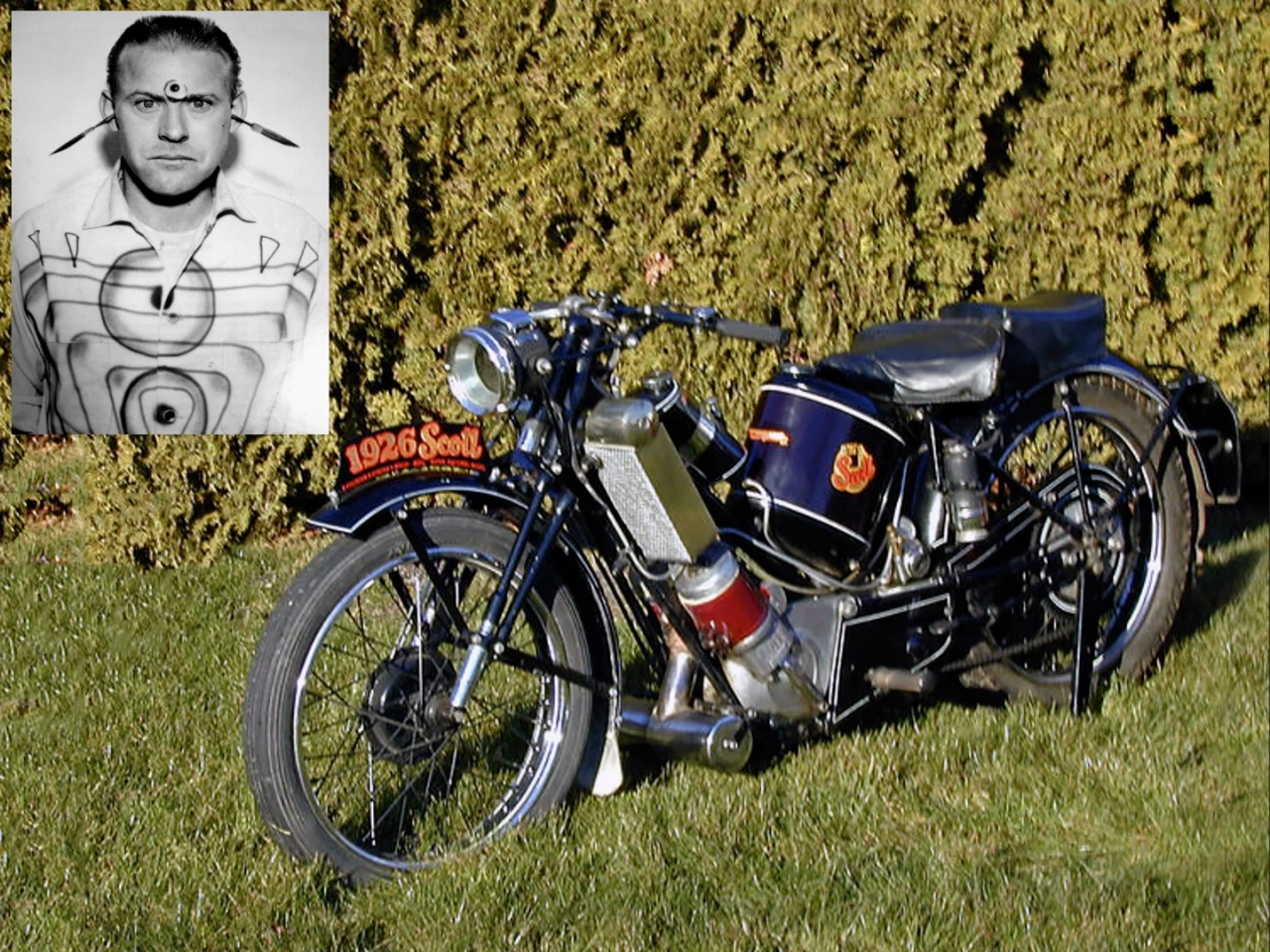
McQueen has now owned the three most expensive two-strokes ever sold at auction, with the record for a two stroke motorcycle being $276,000 for a Scott Flying Squirrel restored by McQueen's mate, the artist Kenny Howard, aka Von Dutch.
Remarkably, without its McQueen ownership and On Any Sunday starring role, this Husqvarna would still be worth the $1500 it sold for a decade ago, so this story superbly illustrates the importance of provenance to the value of any object at auction, and in particular, the importance of high profile media provenance.
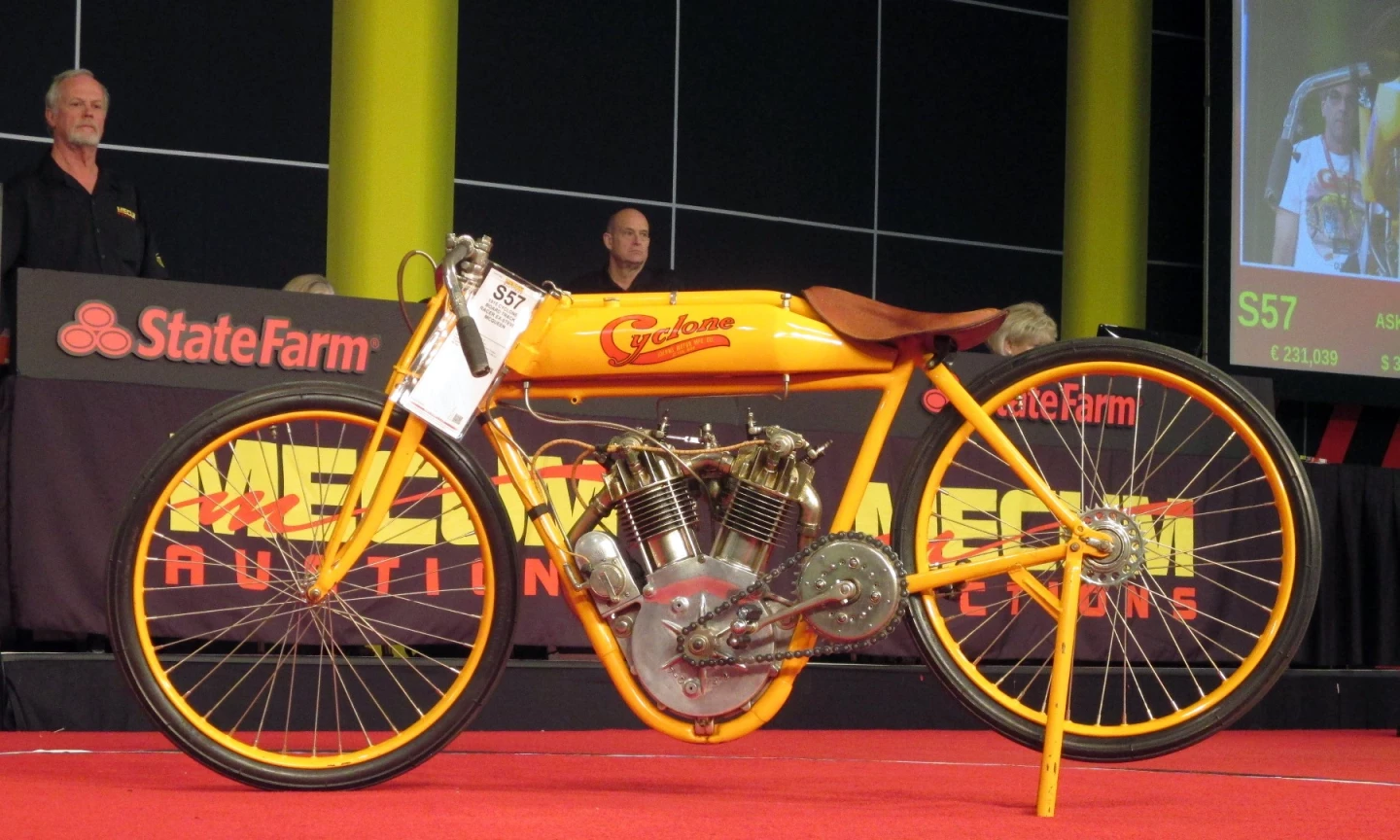
McQueen's feats on the auction block
If any living creatures really have had something resembling the legendary Midas touch, which legend tells us Dionysus bestowed on the King of Phrygia (enabling him to turn whatever he touched into gold), then Terrence Stephen McQueen is one of them.
McQueen's star quality means that many of the items he has touched are subsequently worth several orders of magnitude more at auction. Search the image gallery for this article and our 2014 feature Steve McQueen's Midas touch poised to strike again and you will find dozens of examples of McQueen's belongings having commanded prices many times their true worth or "book value" without his provenance.
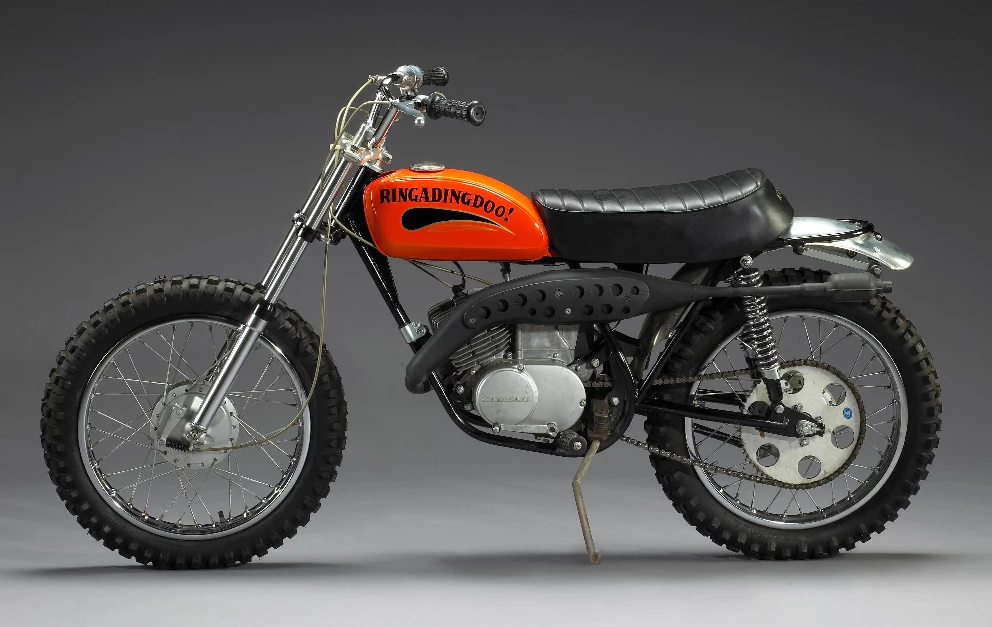
One example that motorcyclists will relate to is the above 1970 G31M Centurian given to Steve McQueen by Kawasaki to be used as a pit bike during the filming of Le Mans. Sold at any other auction without McQueen's ownership in its resume, the 44 year-old 100cc motorcycle would struggle to fetch $100, yet it fetched US$55,575 at auction in 2007.
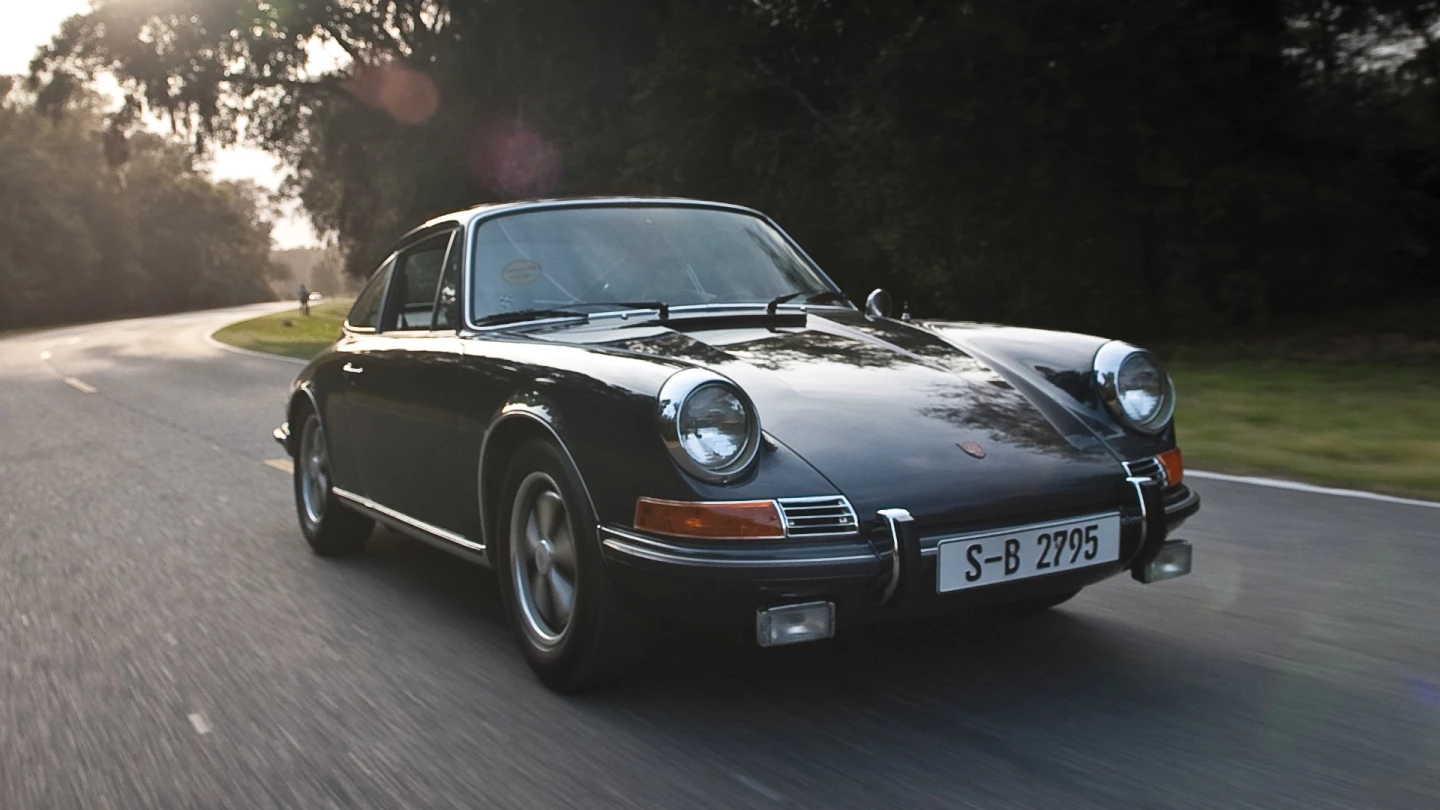
Another excellent example is the Porsche 911S that McQueen drove through the French countryside for the first three minutes of Le Mans (1971), which appears at #18 in our top 100 most expensive movie cars listing. It sold for US$1.37 million in 2011, which is about 10-15 times what you'd pay for an identical car.
Some other examples in other collectible genres include the racing suit McQueen wore as Mike Delaney in Le Mans (1971) that sold for $984,000 at a Profiles in History auction. By comparison, one of Lewis Hamilton's race suits sold to the benefit of charity at Bonhams' Goodwood Festival of Speed auction a few weeks ago. Lewis Hamilton is already the most successful British driver in the history of motorsport, and he's a good chance to add a fifth World Formula One Championship in 2018, drawing alongside Juan Manuel Fangio and behind only Michael Schumacher in the list of all-time F1 championship winners. Charity auctions usually command much greater prices than non-charity auctions, yet Hamilton's race suit sold for $9,912. The racing suit of another all-time great, the late Ayrton Senna, sold at auction in Monaco earlier this year, fetching €38,400 ($43,000). One other McQueen race suit sold at an RM-Sothebys auction in 2017, fetching $336,000.
As the world's highest paid actor and the world's highest profile non-professional motorcyclist, McQueen was in demand. In 1972, McQueen featured in a commercial for Honda's 1973 Elsinore CR250 motocross bike, reportedly being paid $1 million for appearing. That's the commercial above.
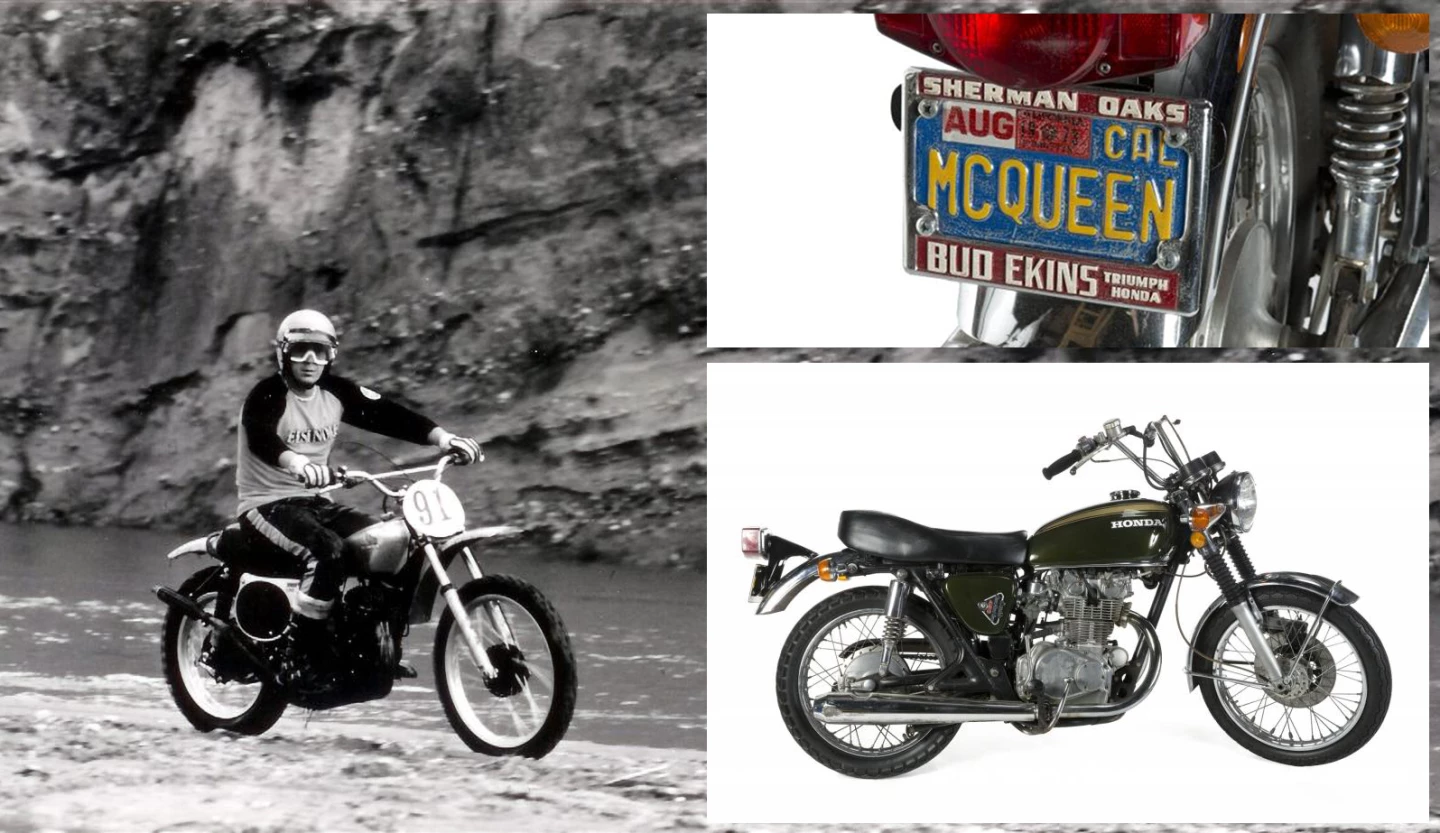
At the same time as the commercial was made, Honda Motor Company gave Steve a CB450 road bike for promotional purposes. The bike is actually mentioned in the superbly researched Matt Stone book McQueen's Motorcycles: Racing and Riding with the King of Cool and exceeded all expectations when it went to auction. The bike fetched $70,400 at a Juliens auction in 2017. Without McQueen's provenance, it would have fetched less than one hundredth of that price, yet with his ownership, it is one of the most expensive Japanese motorcycles ever sold at auction.
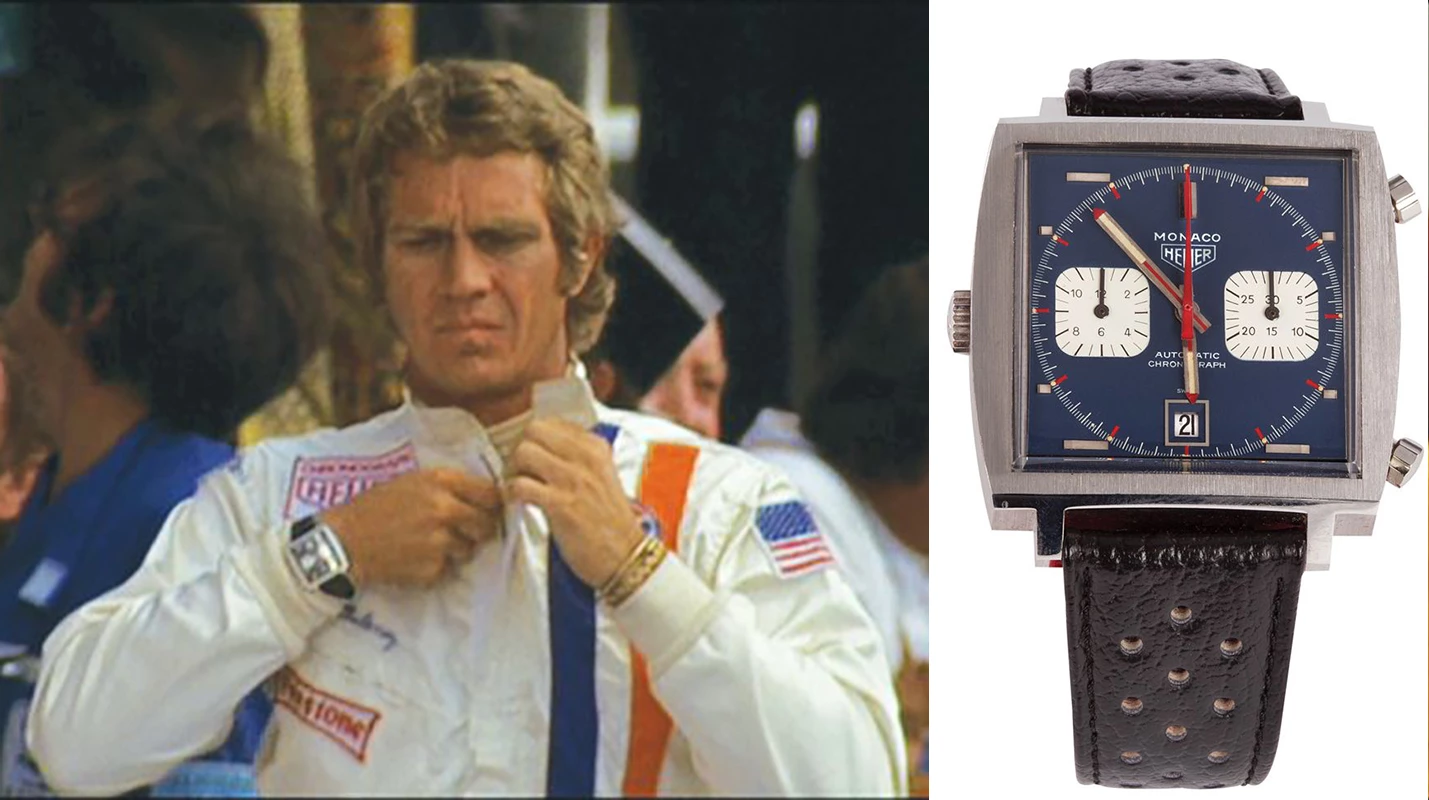
Purchased for $220 in 1970, this Heuer Monaco watch was worn by McQueen during Le Mans, and sold at auction by Profiles in History for $799,500 in July, 2012. It is now in the TAG Heuer Museum in Switzerland. The Heuer Monaco is not however, the watch that McQueen wore in day-to-day life, and in almost any image you see of Steve, he was wearing a Rolex Submariner.
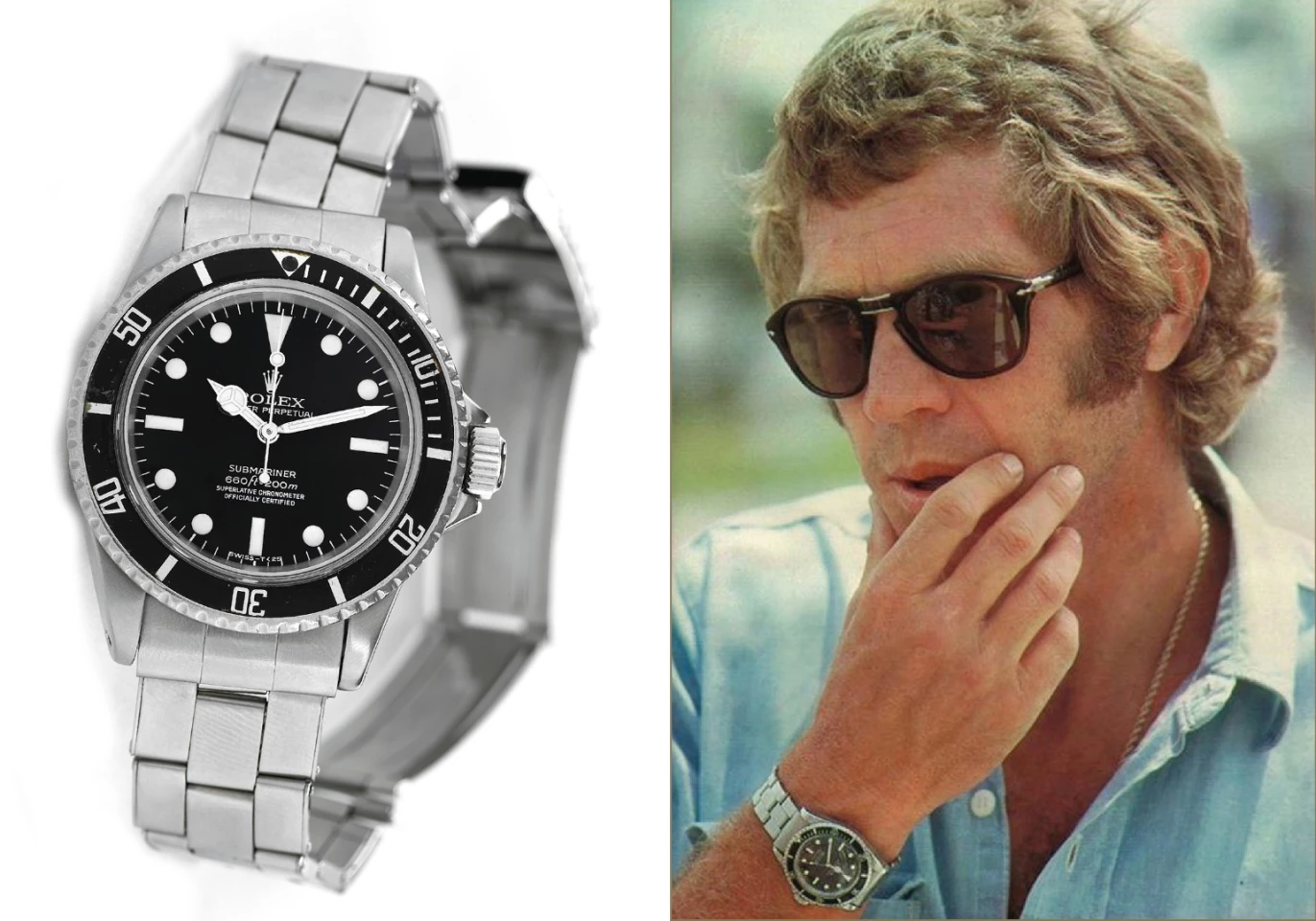
One of his Submariners (Reference 5512) sold for $234,000 in 2009 and another Submariner associated with him is to be auctioned by Phillips in December, 2018. Given that the collectible watch market is hotter than ever, and that Phillips sold Paul Newman's Rolex 6239 at auction last October (2017) for $17,752,500, it is understandable that watches with leading male role movie provenance should begin appearing at auction ... but the provenance of the latest submariner is being hotly disputed, by no less an authority than the McQueen Estate itself. Another golden rule of assessing auction values is that provenance is only valuable if it can be proven.
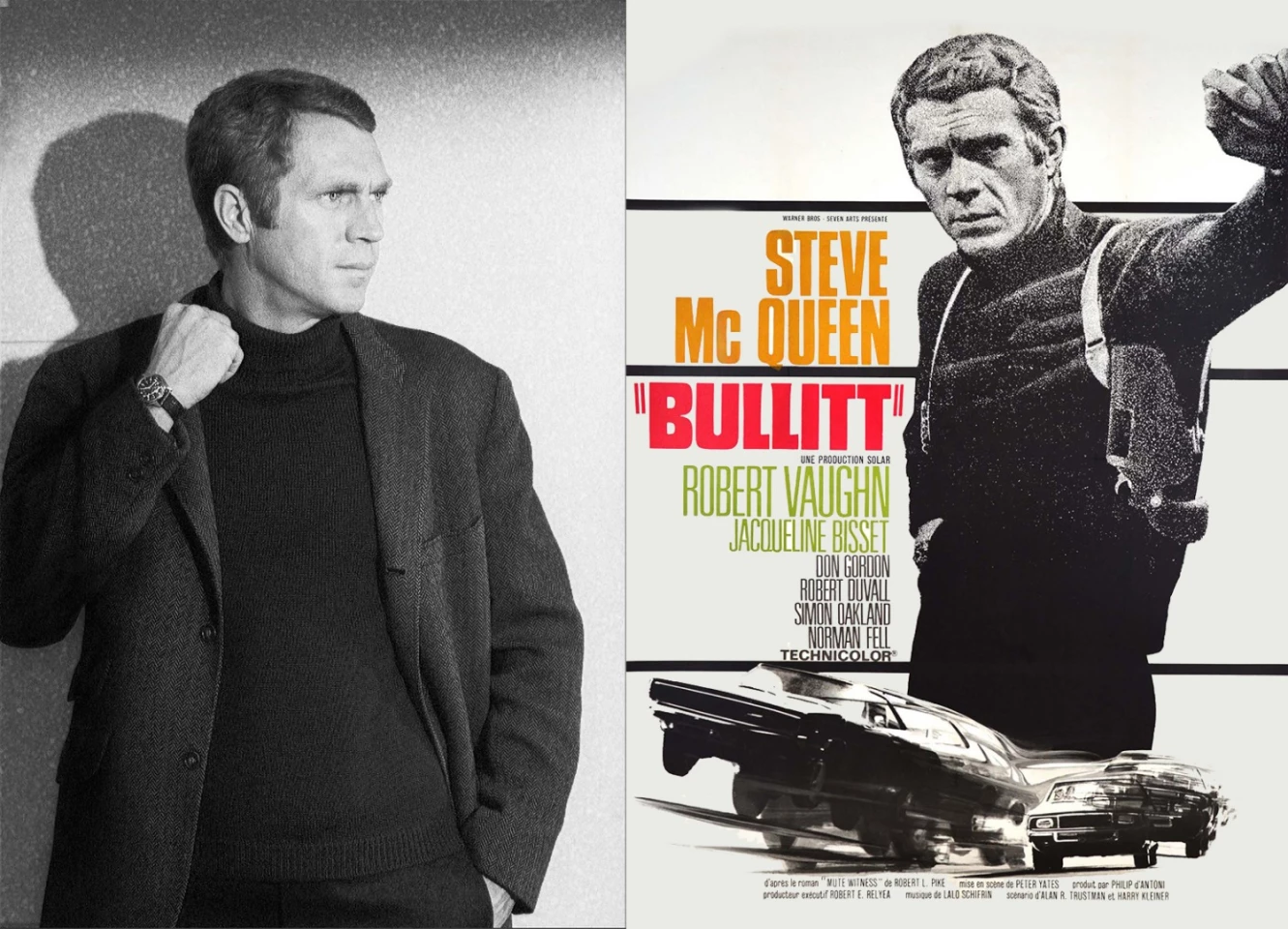
The brown herringbone tweed jacket worn by McQueen in Bullit with a roll neck sweater underneath not only had a significant effect on male fashions of the period, being subsequently exhibited at the Warner Brothers Studio Museum, it went to auction at Profiles in History with a pre-auction estimate of $600,000 and $800,000, selling for $720,000. The buyer failed to pay up, and after several subsequent auctions, it sold for $120,000 in 2014.
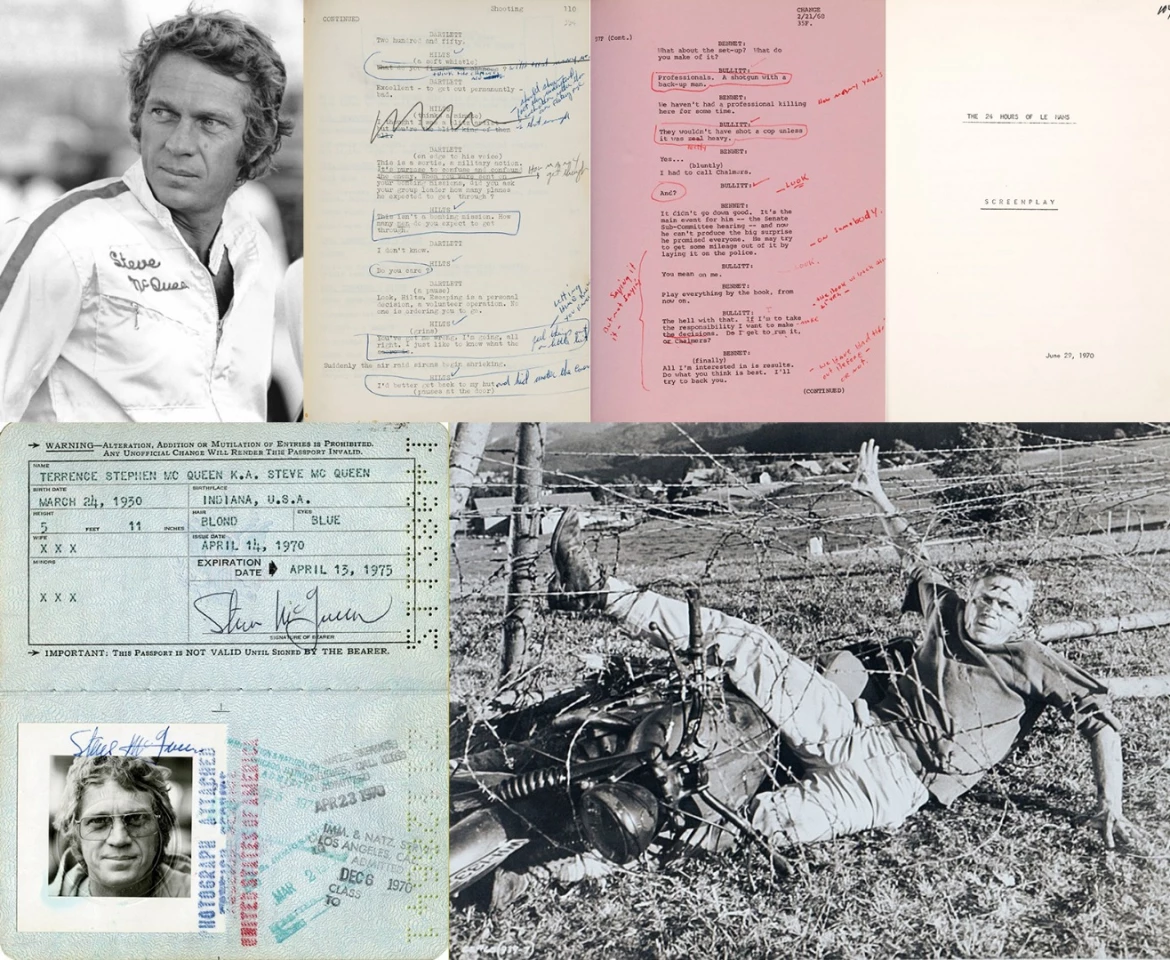
We could go on and on about major items of McQueen memorabilia fetching astonishing prices, but the seemingly minor items are perhaps more indicative of the height of the floor price for his collectibles (from top left): a racing jacket with no film provenance ($50,000); Steve's script from The Great Escape ($40,000); Steve's script from Bullitt ($44,000); Steve's script from Le Mans ($44,000); Steve's passport ($37,500); and Steve's "Virgil Hilts" prison shirt from The Great Escape ($40,000). Yes, that's a $40 grand t-shirt he's wearing.
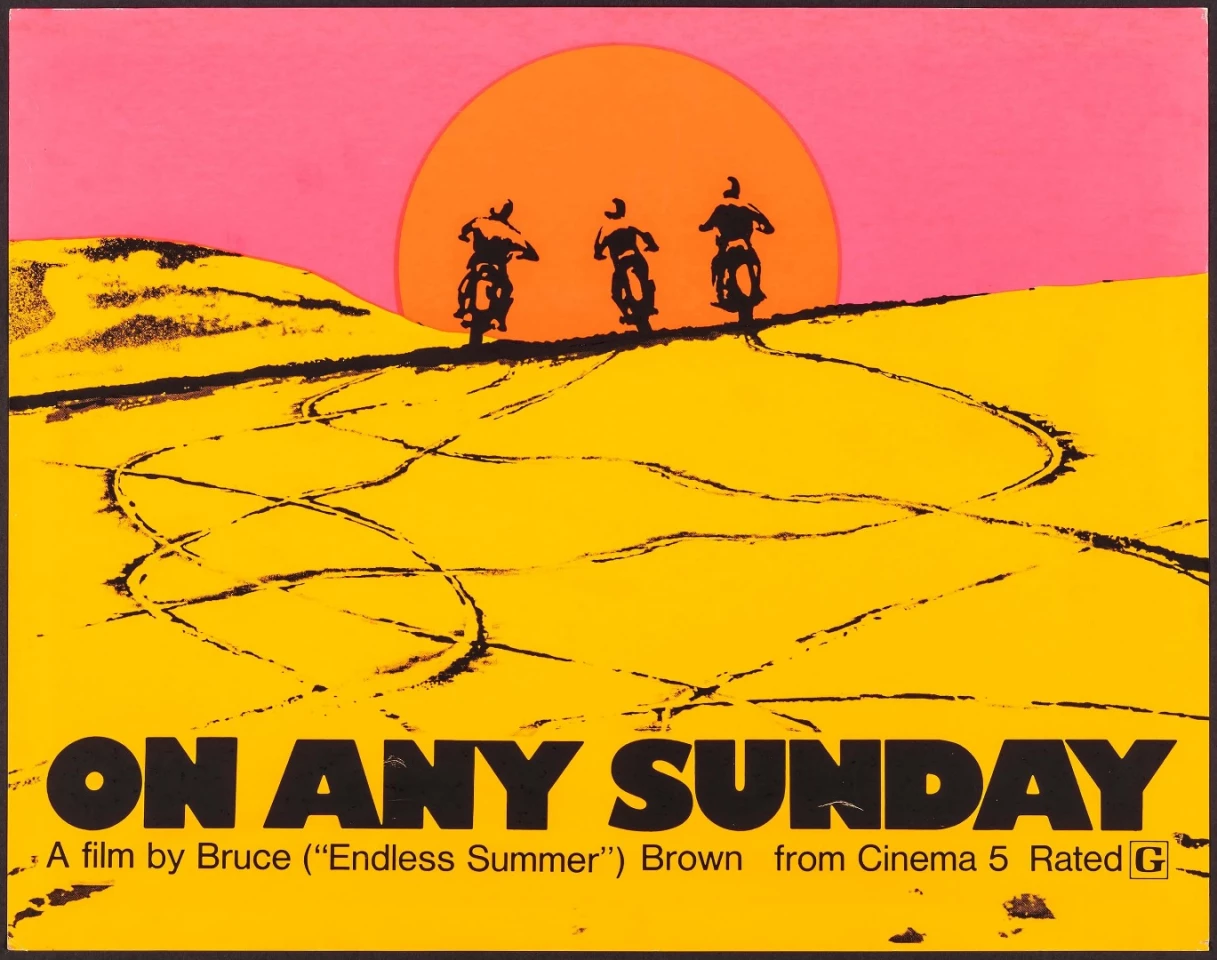
The influence of On Any Sunday
The Endless Summer was Bruce Brown's first globally acclaimed movie, appropriately and beautifully illustrating and eulogizing the surfing lifestyle. On Any Sunday was his second, and it did for motorcycling what Endless Summer did for surfing. Whilst it can't be quantified, Bruce Brown's ability to capture the essence of motorcycling on film arguably inspired millions to embrace motorcycling.
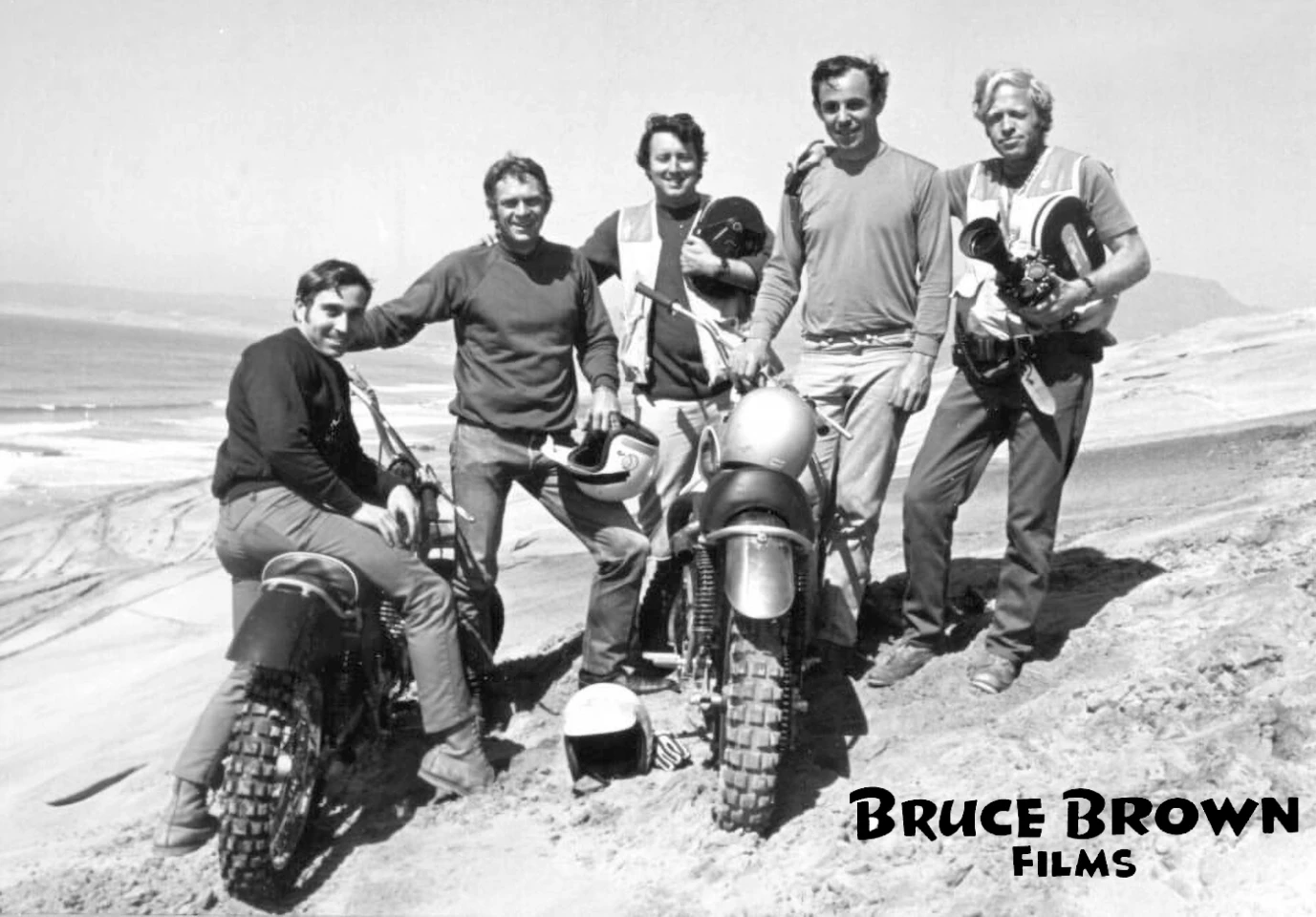
The world's highest paid actor at the time, McQueen starred in the film, backed it financially, helped to promote it once it was released, and it was done not so much as a commercial venture, but to promote one of his great passions in life. It is difficult to tell just how much the film helped to fuel the motorcycle sales boom of the early seventies, as the post-war-baby boom had just reached driving age ... but anecdotally, the influence of On Any Sunday was far reaching.
Malcolm Smith, another star of the film (pictured second from right above, with Bruce Brown's hand on his shoulder), donated the Husqvarna he rode in the film to the American Motorcycle Association Motorcycle Hall of Fame, and in the press release announcing the gift, Smith was quoted thus: "Many remember 'On Any Sunday' as the reason they started riding, and I continue to hear it today. Whenever I'm at a motorcycle event, people always tell me that watching me enjoying riding so much in the movie was the reason they got into bikes, and they're so happy they did. I always ask them what their lives would have been like if they hadn't discovered motorcycles... they can't imagine it! "
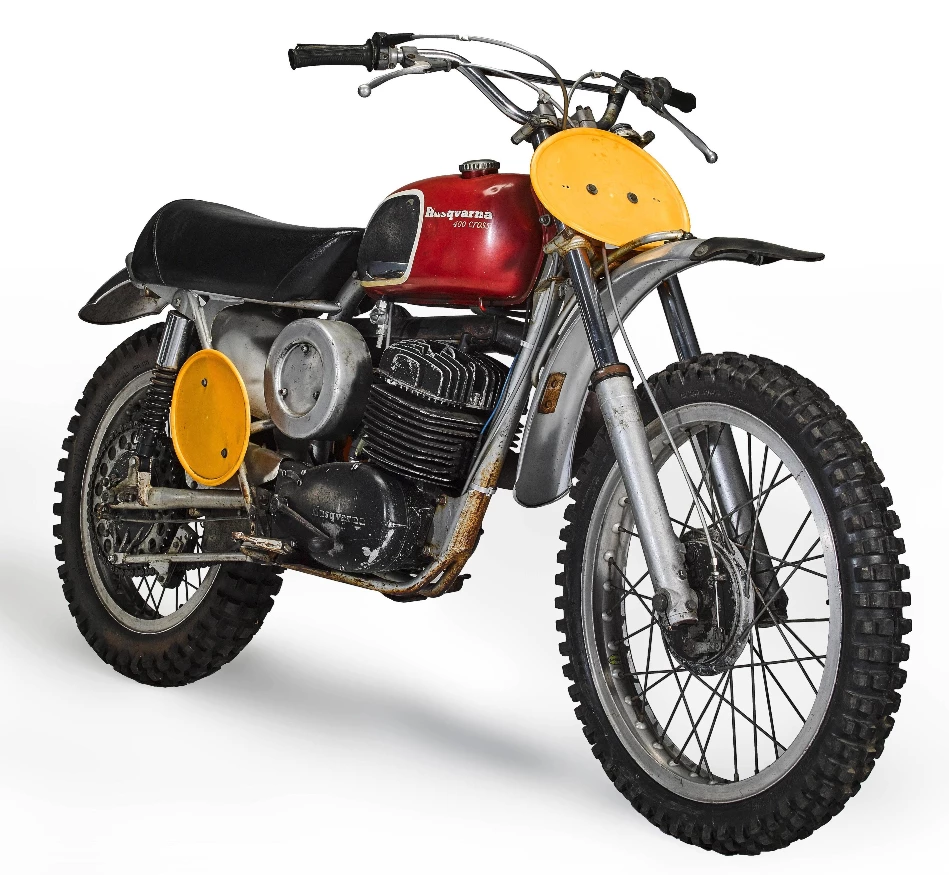
The forensics behind the 'On Any Sunday' bike
The real On Any Sunday McQueen Husqvarna had never been identified until recently because Steve McQueen owned many Husqvarnas, beginning in 1968, including at least three 400 Cross models and there was no definitive proof as to which bike had been used in the filming.
Indeed, just over a decade ago, Husqvarna enthusiast and restoration expert Rob Phillips of Huskyrestoration.com, purchased 1970 Husqvarna 400 Cross #MH-1341 (the bike being sold at auction on October 6, 2018) for $1500 with the aim of restoring it.
Rob did some research and when he tracked down the original sales documents and Manufacturer's Statement of Origin, he discovered #MH-1341 had been purchased new on February 9, 1970 by McQueen's production company, Solar Productions.
As detailed in McQueen Online, #MH-1341's second owner purchased it from a Californian motorcycle dealer in May 1972, (and would have hence been unaware of the celebrity connection) and raced it for a few years in the same area McQueen raced in, before putting in the shed, where it sat until January, 2008. The bike was apparently sold twice that month, and was purchased by Phillips the following month, February, 2008, for $1500. Given that it changed hands several times, it might have actually sold for even less than the first identifiable second-hand sale price of $1500.
Apart from being the bike involved in many of the riding scenes in the film, Phillips believes that this was most likely the #98 Husqvarna McQueen rode under his pseudonym of "Harvey Mushman" in the 1970 Lake Elsinore Grand Prix, which was also seen briefly in On Any Sunday.
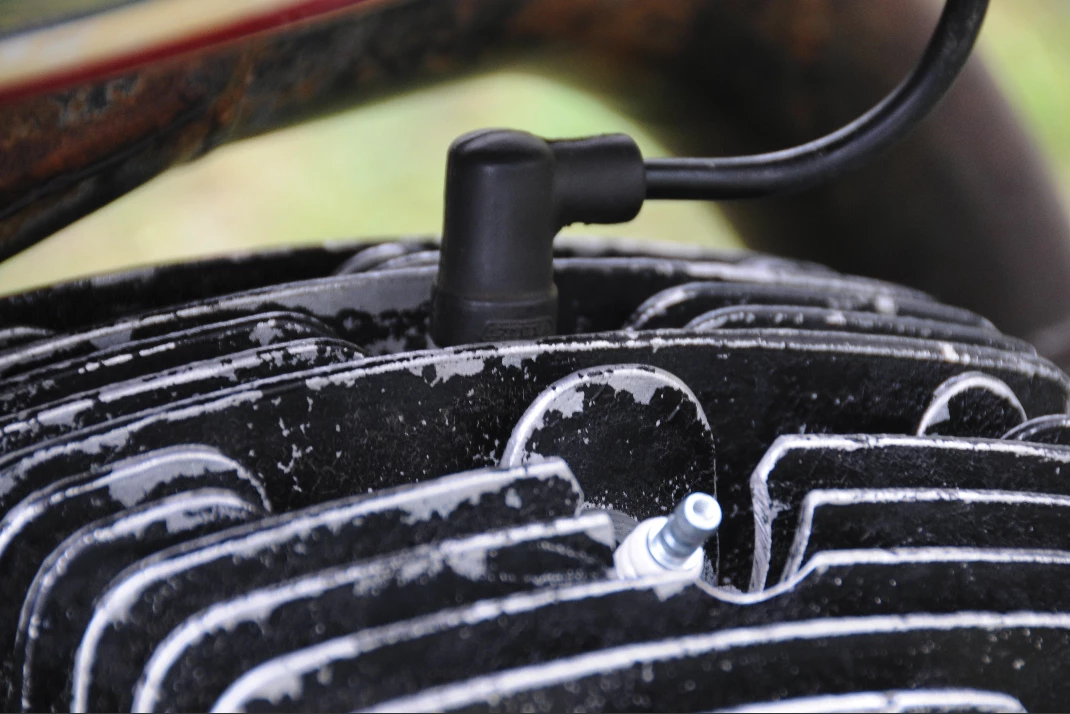
Quoting from McQueen Online: ... the 'On Any Sunday' motorcycle that he (McQueen) rode can be seen to have a compression release. The lever can be seen on the left side of the handle bars. The motorcycle cylinder head must be modified, professionally, with a second sparkplug hole to install this release (the Husqvarna factory never supplied this option), and (this) bike does have the modified cylinder head. Also, the exhaust pipe on the 'On Any Sunday' bike appears to have a modified tail pipe, and again, (this) bike has a modified tail pipe. Lastly, the bike was bought by Solar Productions on February 9, 1970 and the McQueen/Elsinore race featured in the film took place on March 7-8, 1970.
Following a sympathetic restoration, #MH-1341 went on display at the San Diego Auto Museum and in January, 2013, it was presented for sale at auction with the McQueen provenance as its main selling point.
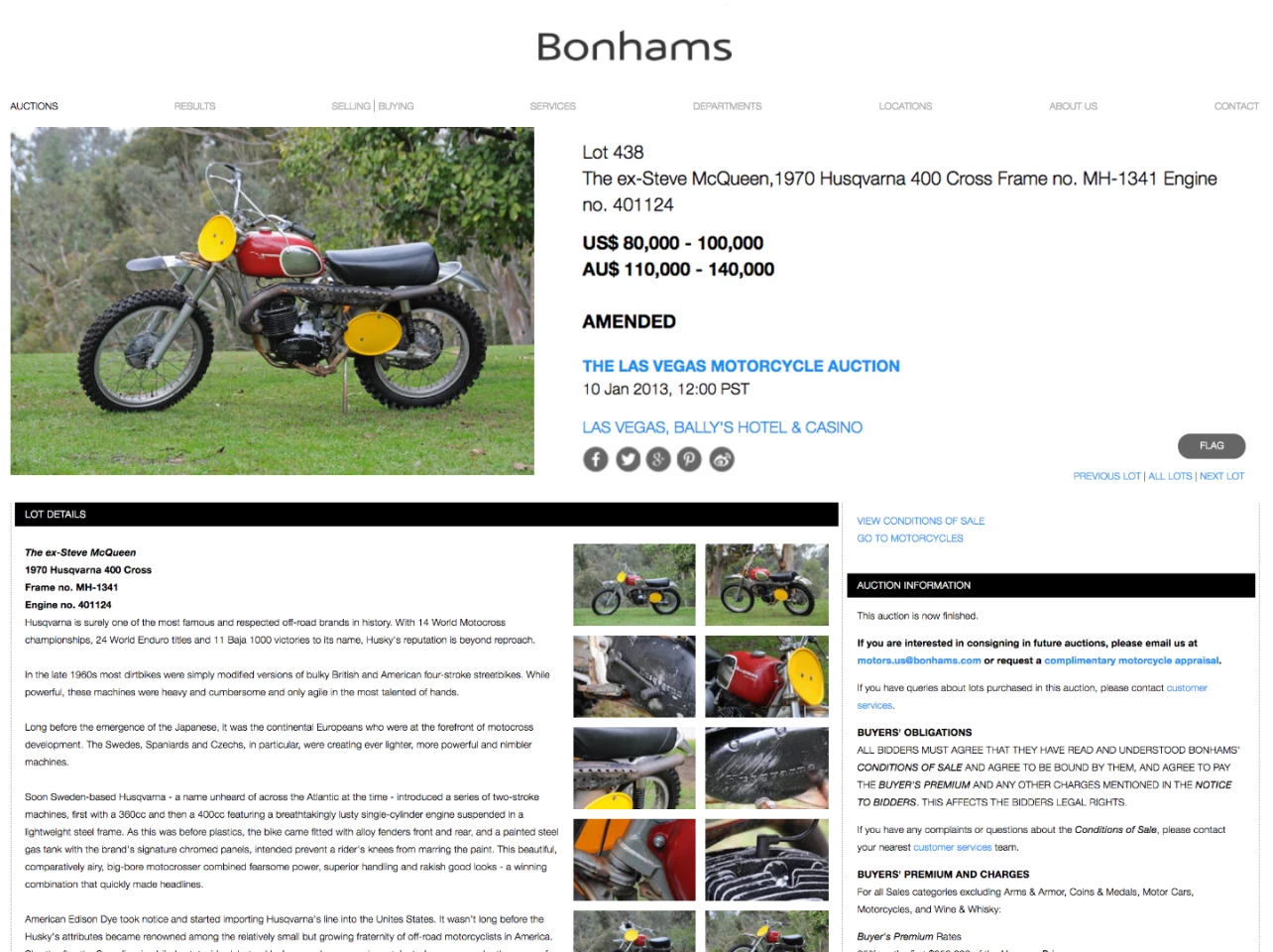
In the 2013 auction, Bonhams estimated Husqvarna #MH-1341 would sell for between $80,000 and $100,000 because of McQueen's provenance, but bidding failed to meet the reserve price and the bike was passed in. American laws stipulate that the reserve cannot be higher than the lowest estimate, so a bid of $80,000 would have secured the bike. Some time after that auction on January 10, 2013, Husqvarna #MH-1341 was sold privately to the current consignor who set about researching its history further.
If you read Wikipedia's entry for On Any Sunday, you'll find reference to the support McQueen offered to Bruce Brown in the making of the film: At one point, Brown found a perfect location for a sunset beach riding shot—Marine Corps Base Camp Pendleton. "I figured there would be no way to get approval to film on the Marine base," Brown recalls. Steve said he'd see what he could find out. The next day he called and I was told to contact some General and the next thing you know we are shooting the beach sequences. It was pretty amazing the doors he was able to open."
That thread turned out to be the connection between the bike that wasn't sold at auction in 2013, and the bike that set a raft of auction records in October, 2018.
Camp Pendleton is the place where the United States Marine Corps trains its warrior elite. Non-military individuals don't get access to this restricted training facility without some rules being bent, and even then, protocols had to be followed, even if you are the best known actor in the world. When Bruce Brown contacted the General in charge, he was granted access for filming but he needed to itemize the motorcycles he was taking inside.
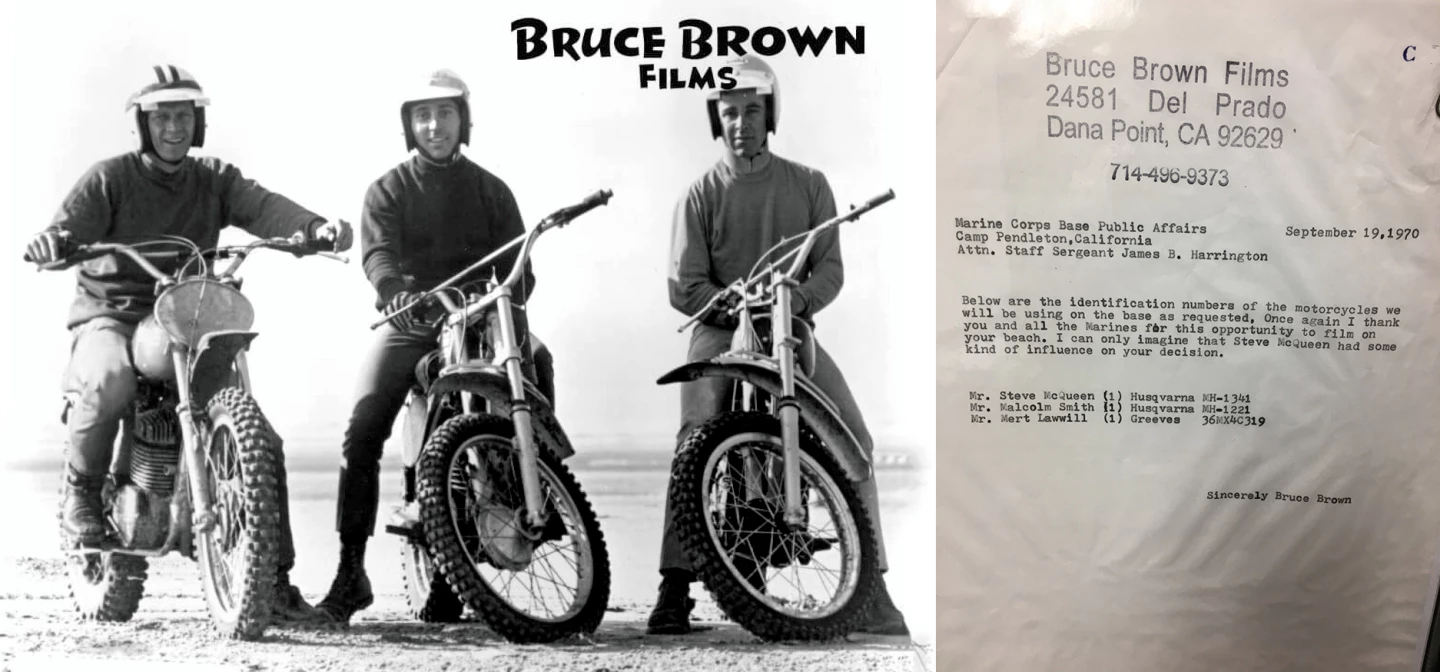
When the current vendor approached Nancy Brown, daughter of filmmaker Bruce Brown (who passed away on December 10, 2017), the letter at above right provided the evidence needed to support the fact that Husqvarna #MH-1341 was the motorcycle used in the filming of On Any Sunday. There's a hi-res image of the letter in the image gallery. That's McQueen on MH-1341, 1969 AMA Grand National Championship Mert Lawwill in the center on Greeves #36MX4C319 and Malcolm Smith at right on Husqvarna #MH-1221 on the beach at Camp Pendleton in September 1970. Malcolm's list of career wins is much too long to list in its entirety, but includes eight gold medals in the ISDT (now ISDE), six Baja 1000 wins (three on motorcycles, three in cars), four wins in the Baja 500, two Mint 400 wins and a win in the Roof of Africa Rallye.
The most famous motorcycles in popular culture
Our research shows that the most famous motorcycles in popular culture correlate strongly with the most valuable motorcycles sold at auction. There are a few key images that captured landmark moments where motorcycles had their 15 minutes of fame, or have been beloved by famous people. Not surprisingly, if they have appeared at auction, these motorcycles have sold for a fortune.
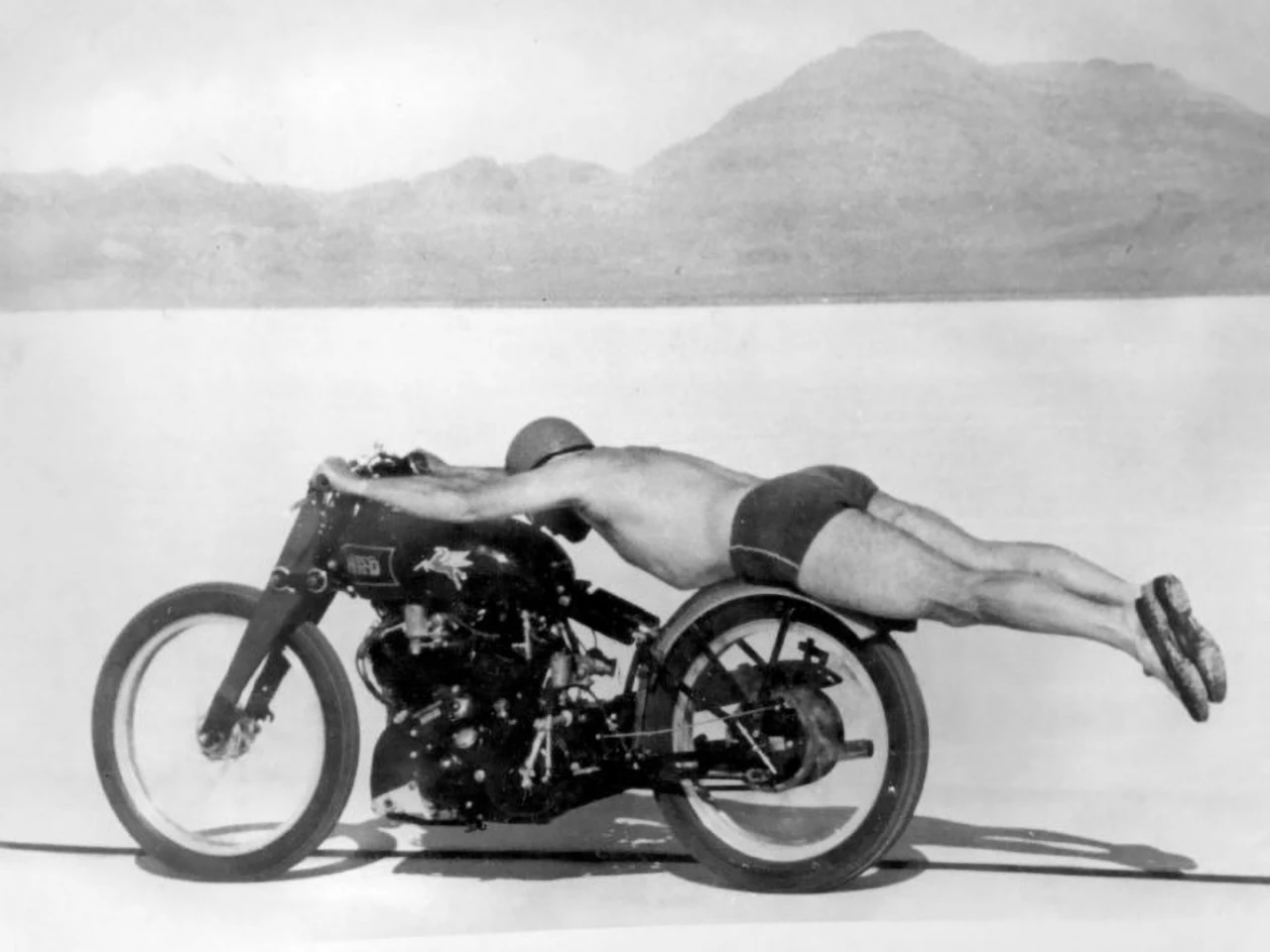
The Vincent ridden by Rollie Free in his bathing suit
Possibly the most memorable single image of a motorcycle is the above photograph of Roland "Rollie" Free breaking the American motorcycle land speed record on September 13, 1948 at Bonneville. Unable to beat the record in his leather racing suit, he had the idea of doing it "au naturel" to reduce wind resistance, subsequently registering a run of 150.313 mph (241.905 km/h) on his Vincent HRD 1000cc V-twin with the famous image recorded during that run. Given that Bonneville came to prominence as a venue for land speed record attempts because it is a vast salt flat, a blown tire or one of those unstoppable tank-slappers that every motorcyclist dreads, would almost certainly have seen Rollie sandpapered into the scenery. The image captures so much of the mix of freedom and imminent danger that is at the very core of motorcycle competition.
The Vincent in this image was found and restored by attorney-restorer-historian-curator-of beautiful-objects Herb Harris, and reluctantly sold when he was made an offer he couldn't refuse. The bike reportedly changed hands privately for $1.1 million.
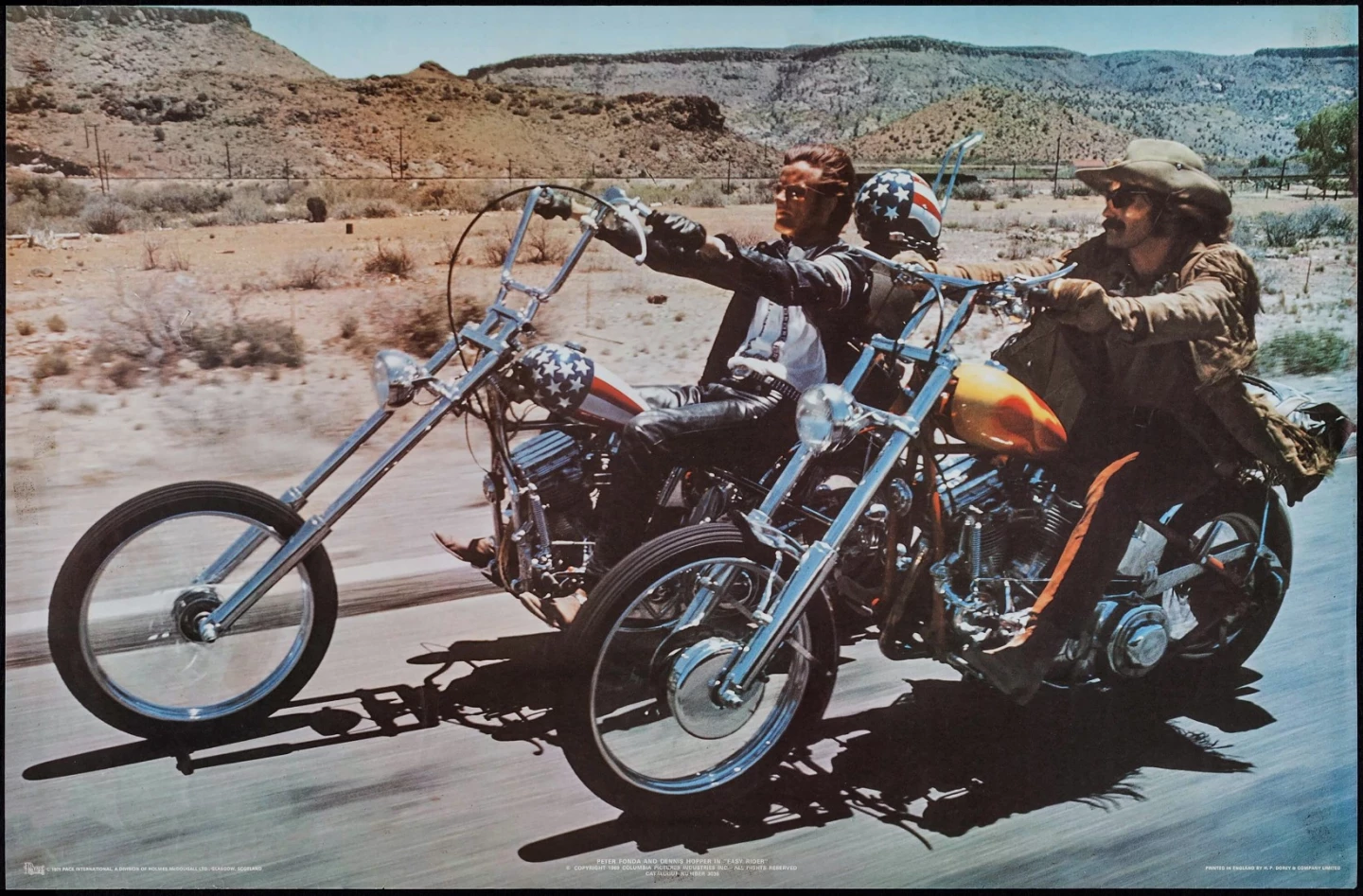
The Captain America Harley from Easy Rider
Equally as recognizable was the Captain America Harley ridden by Peter Fonda in Easy Rider. There was a lot of controversy surrounding the sale of this bike at a Profiles in History auction, when it was hammered down for $1.65 million, then the buyer backed out, uncertain the bike was the real deal. We reported the sale at the time, but subsequently removed the bike from our auction listing when the sale was annulled and everything went quiet. In the aftermath, the Harley is believed to have sold privately for around $1.3 million in 2014.
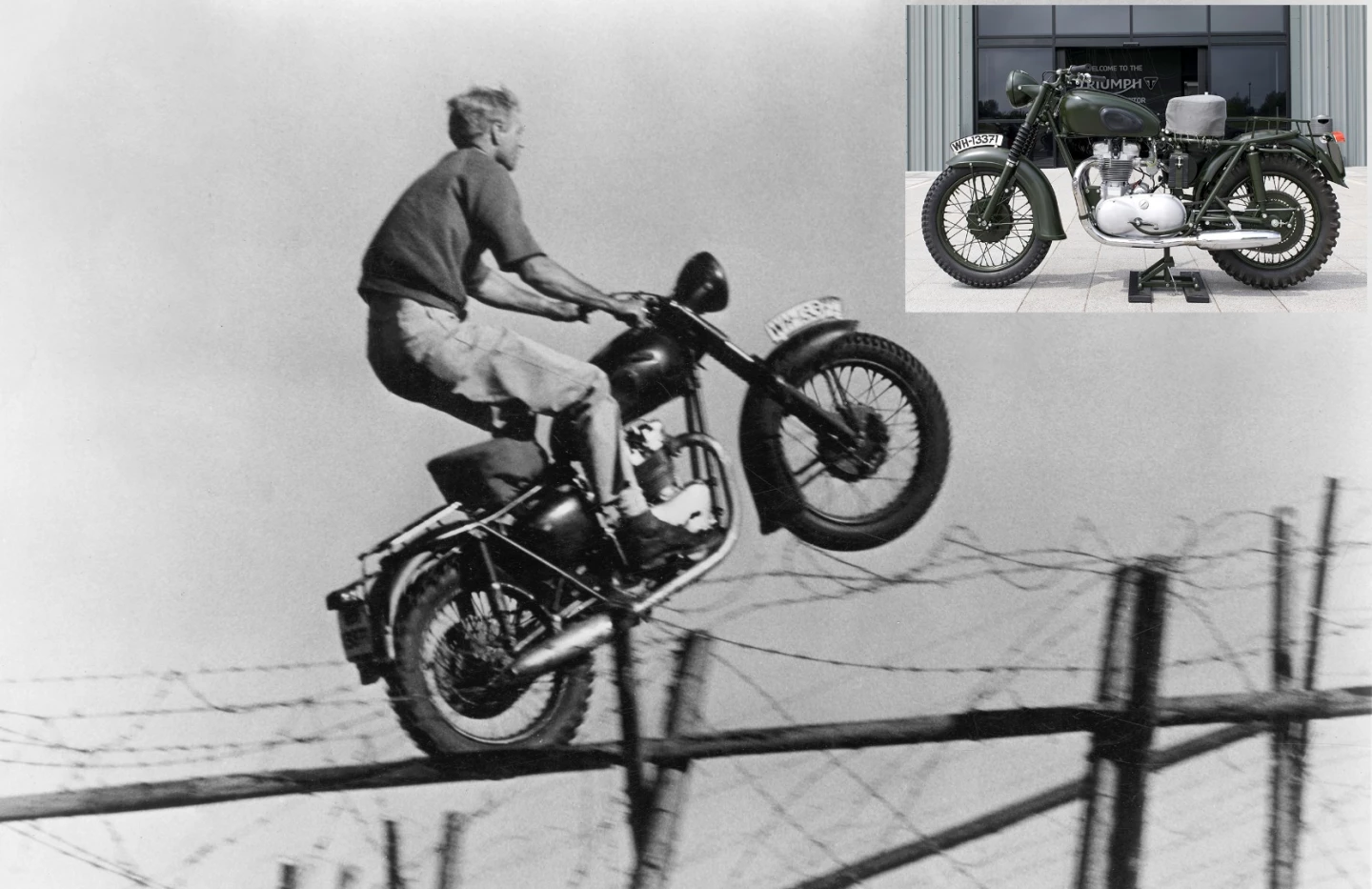
The Triumph Trophy from The Great Escape
In the film, The Great Escape, Steve McQueen's character jumps a fence on a Triumph TR6 Trophy while being pursued by prison guards. Due to insurance reasons, McQueen wasn't able to perform the main motorcycle stunt in the movie, and the task fell to his great mate Bud Ekins. Bud and his brother Dave Ekins maintain their own web site and the story of what happened is recorded there in Dave's own words.
This Triumph Trophy has never been to auction, remarkably having spent the majority of its life herding cows in Germany before being locked in a barn for a further few decades. When found, it was restored, and in recent years has been one of the hero exhibits at the Triumph Factory Visitor Experience, and was on show at this year's Salon Prive Concours on August 30, 2018.
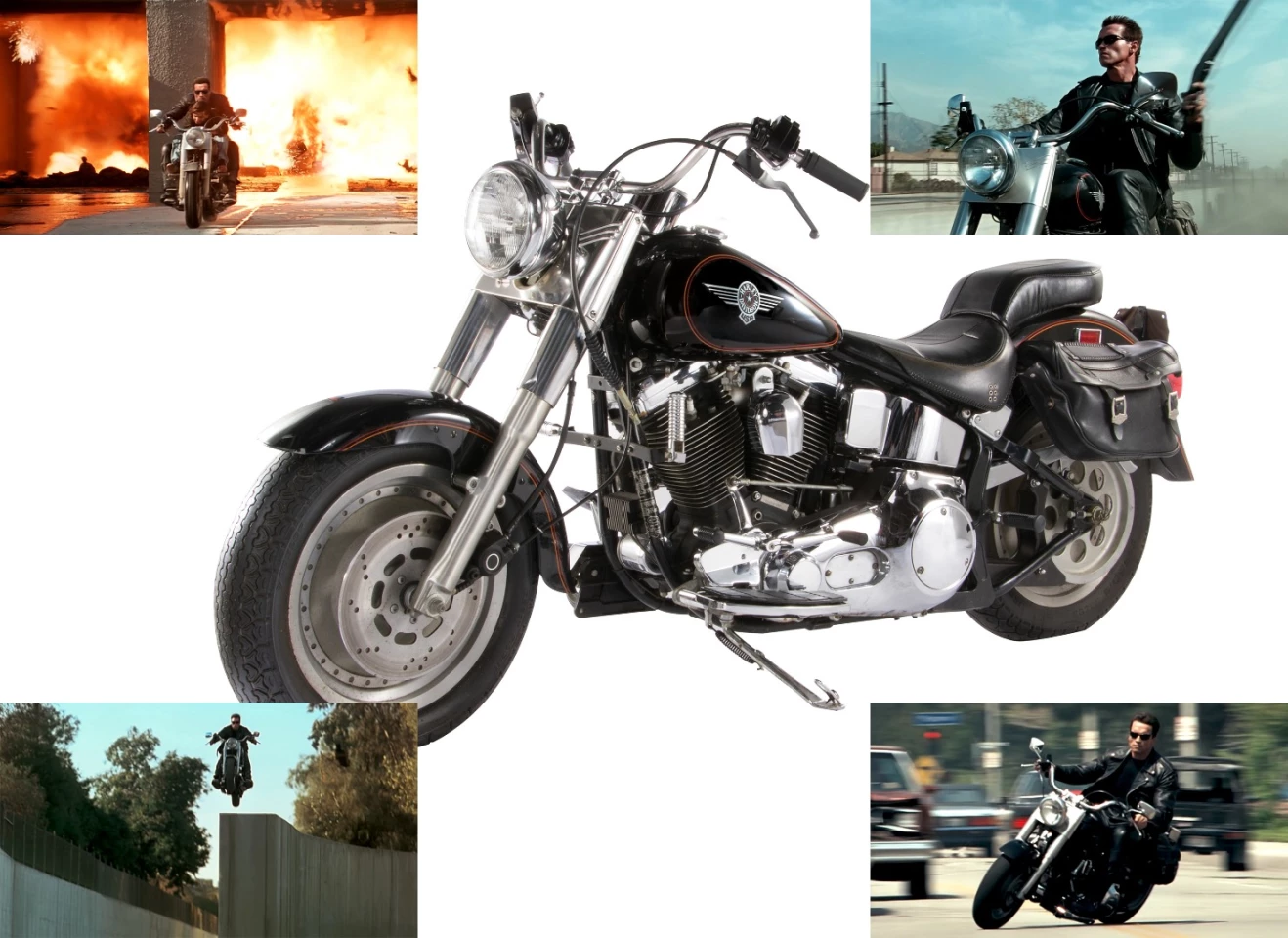
The Harley-Davidson Fat Boy from Terminator 2: Judgment Day
Perhaps not a single image, but as media has evolved from still to moving images, the Harley-Davidson Fat Boy from the 1991 movie Terminator 2: Judgment Day is certainly one of the most prominent motorcycles in media history. In the movie, Arnold Schwarzenegger plays a Cyberdyne Systems Model 101 T-800 humanoid terminator robot sent back in time and tasked to safeguard a young John Connor. After commandeering the Harley, Arnold takes on a truck in what is arguably the greatest motorcycle movie chase scene of all time.
In addition to grossing $523.7 million worldwide at the box office, the movie won several Academy Awards, and was one of the first movies to make extensive use of cutting edge computer animation, further enhanced by being part of one of the most successful movie franchises of all time. In terms of reaching the greatest audience possible, this film was remastered for 3D and re-released in August 2017. Additionally, Arnie, who makes a very convincing robot, and the Harley-Davidson appeared on all the promotional material, from the movie posters to the trailer, video box & DVD covers.
The Terminator 2 Fat Boy sold at a Profiles in History auction for $512,000, beating out Pope Francis's 2013 Dyna Super Glide (€241,500 | $327,000) as the most expensive modern day Harley-Davidson to sell at auction. It also became the second most expensive Harley-Davidson ever to sell at auction, behind only a 1907 Harley-Davidson "Strap Tank" Single($715,000).
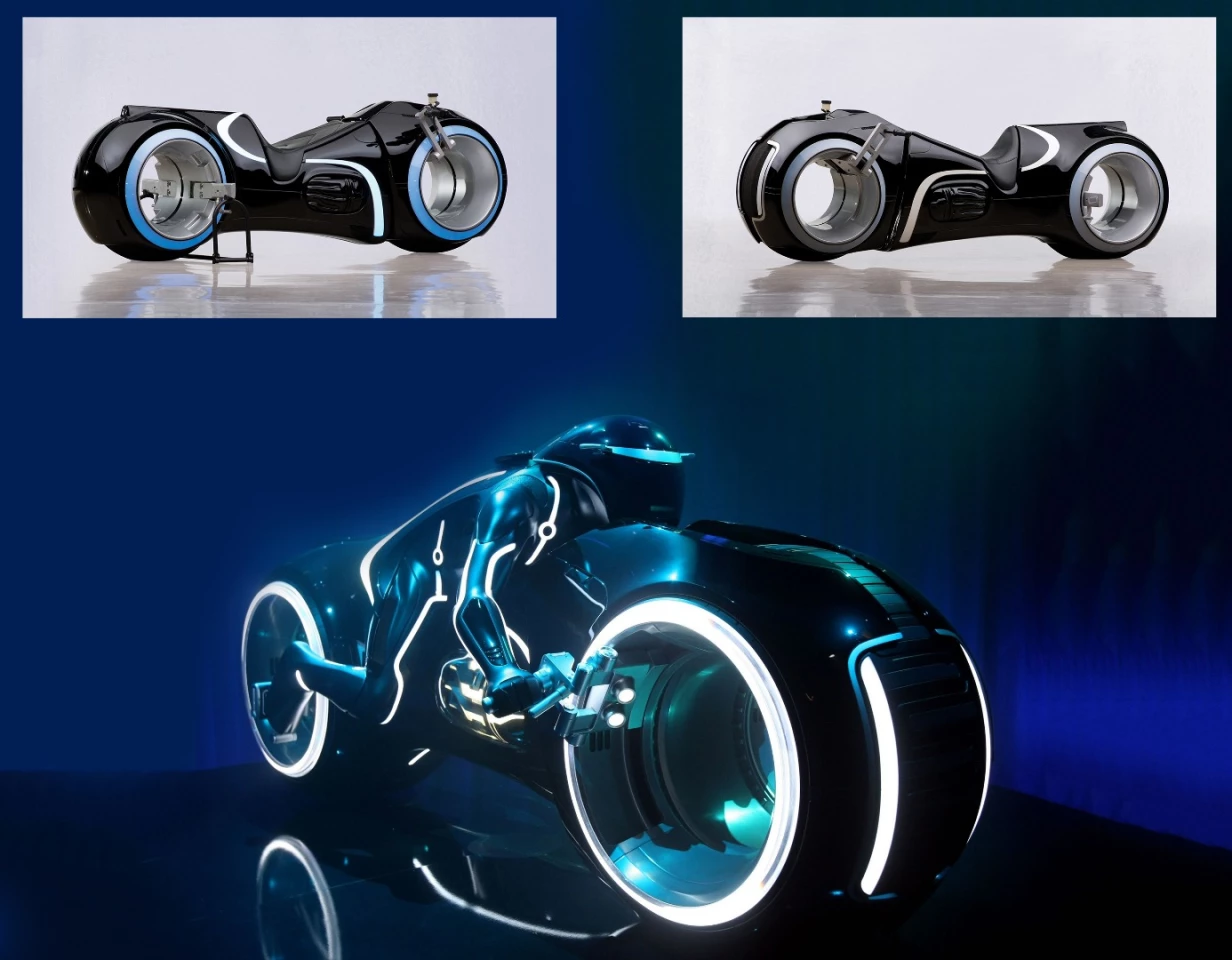
The Lightcycle from Tron
The Tron story is as compelling and fascinating as it is prophetic in its digital to off-line transition, and the Tron Light Cycle evolved from the original 1982 film to become quite realistic in the 2010 sequel Tron: Legacy. Unlike all prior movie motorcycles though, the Light Cycle did not exist beyond computer animation, so father and son car collectors Paul and Chris Andrews actually created a real-life Tron Light Cycle. When the Andrews sold their collection in 2015, the fully working Tron replica was sold for $77,000.
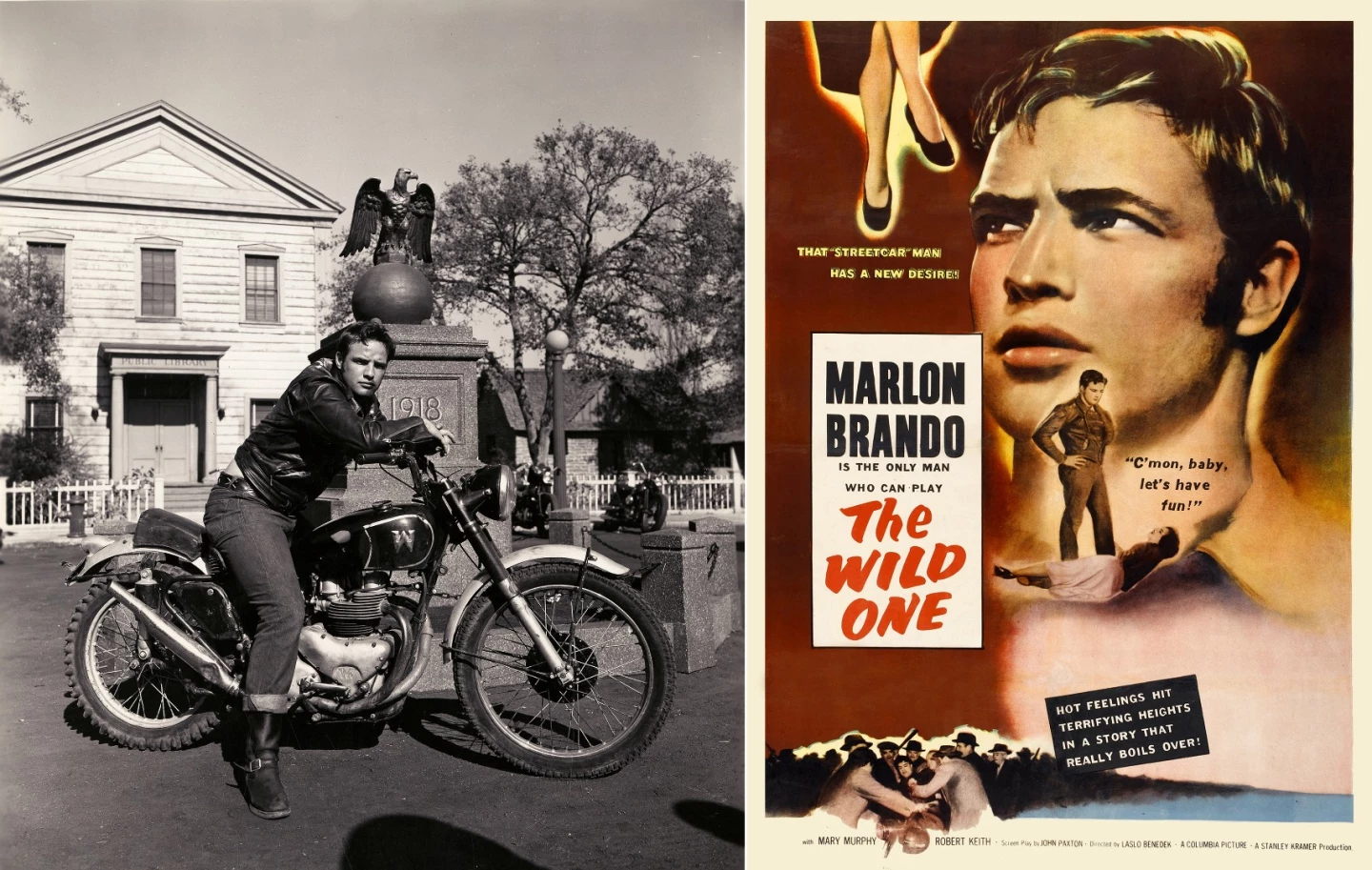
The Triumph Thunderbird from The Wild One
The 1953 movie The Wild One, starring Marlon Brando as Johnny Strabler, created a worldwide sensation and helped propagate outlaw biker culture to the world. In the movie, Brando's character rode a 1950 6T Triumph Thunderbird and when asked "what are you rebelling against Johnnie?", his reply captured the brewing mood of American youth: "whaddaya got?" Though there is no one image of Brando with the Triumph that stands as iconic, the portrait of him astride the bike above is perhaps the best known. The Triumph Thunderbird he rode in the film has never been to auction and is either secreted away in someone's collection or has been lost to history.
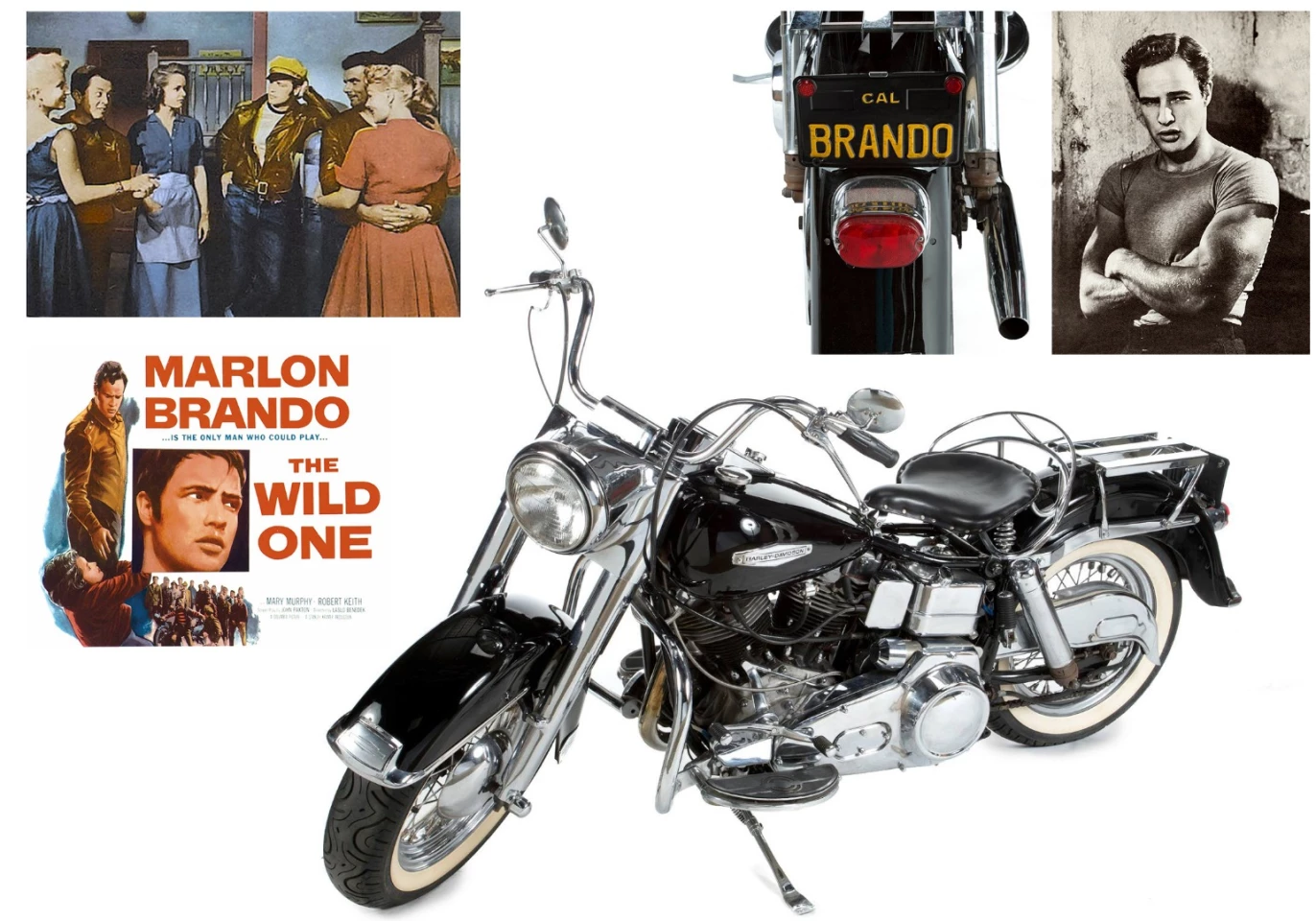
Marlon Brando was a real-life motorcyclist though and when the 1970 Harley-Davidson FLH Electra-Glide he owned from new went to auction, it sold for $256,000 at a Julien's Hollywood Legends auction. Brando won two academy awards for best actor from eight nominations, and despite many famous film roles (A Streetcar named Desire, The Godfather, Last Tango in Paris, Guys and Dolls, On the Waterfront, Julius Caesar, Apocalypse Now and Mutiny on the Bounty, it was his role as the leader of the pack in The Wild One (1953) which indelibly linked him to motorcycling.
The following Brando quote further establishes his two-wheeled bonafides: "It still pleases me to be awake during the dark, early hours before morning when everyone else is still asleep. I've been that way since I first moved to New York. I do my best thinking and writing then. During those early years in New York, I often got on my motorcycle in the middle of the night and went for a ride - any place. There wasn't much crime in the city then, and if you owned a motorcycle, you left it outside your apartment and in the morning it was still there. It was wonderful on summer nights to cruise around the city at one, two, or three a.m. wearing jeans and a t-shirt with a girl on the seat behind me. If I didn't start out with one, I'd find one."

Fonzie's Triumph Trophy 500 from Happy Days
One of the most enduring motorcycles in popular media was the 1949 Triumph 500cc Trophy ridden by Arthur Fonzarelli ("Fonzie" or "The Fonz", played by Henry Winkler) during the 11-year run (1974-1984) of the television sitcom Happy Days. Beginning as a bit player in the series, the leather-jacketed Fonz and his motorcycle became major characters over the 11 seasons of the hit television show due to his ultra-cool persona.
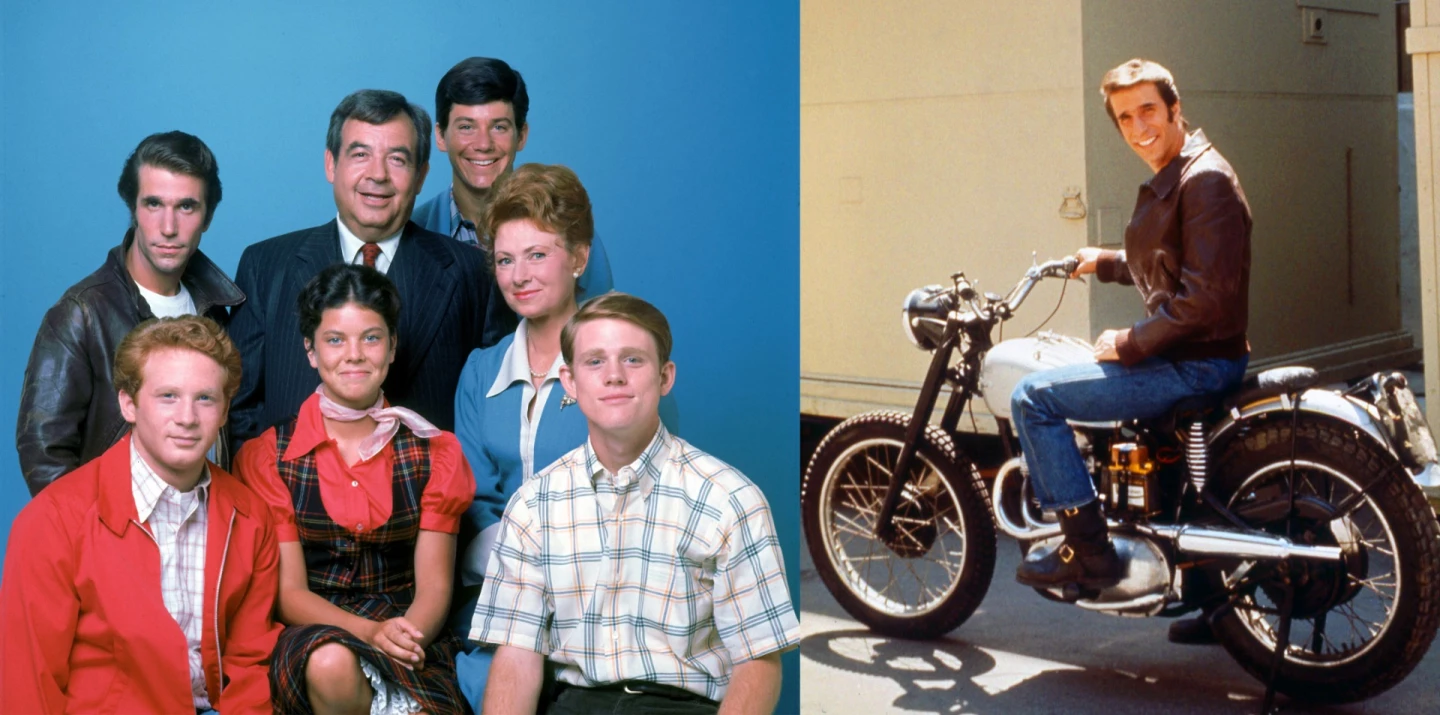
In 1999, TV Guide ranked Fonzie number #4 in its 50 Greatest TV Characters of All Time and his leather jacket is on exhibit in the Smithsonian Institution, the world's largest museum and research complex. The Triumph Trophy has been sold several times at auction, including Bonhams in 2011 (estimated at $60,000 to $80,000 and reportedly fetching $87,500), Profiles in History in 2015 (estimated at $130,000 but failing to make reserve) and most recently at Juliens in Los Angeles earlier this year, where it sold for $179,200. That price makes it by far the most expensive Triumph ever to sell at auction, surpassing the 1973 Triumph/BSA Formula 750 Factory Racer that fetched $104,760 in Mecum's Las Vegas auction in January, 2014.
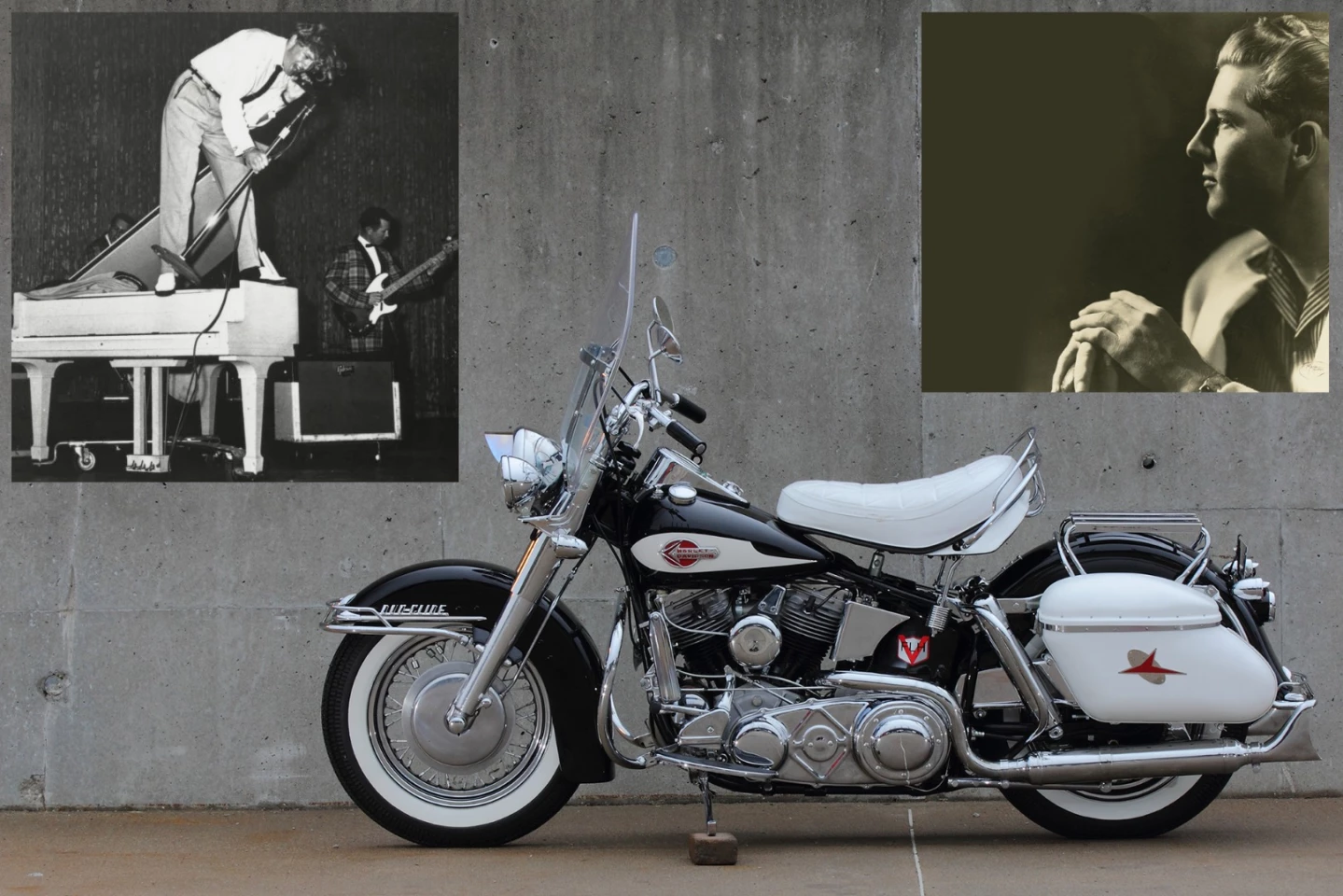
Jerry Lee Lewis' 1959 Harley-Davidson FLH Panhead Duo-Glide
"The Killer," as Jerry Lee Lewis was known even before he became famous, was rock & roll's original "bad boy" and if there's an irony, it's that the he has outlived nearly all of music's wild men and women, yet had his first hit five years before the Beatles or the Rolling Stones. He broke ALL the rules (including marrying his 13-year-old cousin), while accumulating a dozen gold records, several Grammy awards, a Grammy Lifetime Achievement Award, membership of the Rock and Roll Hall of Fame and was ranked by Rolling Stone as number #24 on its list of the 100 Greatest Artists of All Time.
Perhaps less well known is that the Killer is an ardent motorcyclist and has had a stable of Harleys since having his first hit record over 60 years ago. Pride of place in the collection was this 1959 Harley-Davidson FLH Panhead, which was given to him by Harley-Davidson 59 years ago. Elvis Presley got one on the same day.
"There was a time I wouldn't take a zillion dollars for it, but now it's just sitting there", said Lewis when he was selling the bike in 2015. "You can crank that motorcycle up and she purrs like a kitten – but you have to kickstart it you know. I could probably sit on it alright today, but I wouldn't take a chance. I'm 79 years old. This bike is like a child to me, but I've decided it's time to let it go." The Panhead sold for $385,000 on January 24, 2015 at a Mecum auction, and Jerry got up on stage and sang his hits "Whole Lotta Shakin' Goin' On" and "Great Balls of Fire" during the auction.
Buddy Holly's Ariel Cyclone 650
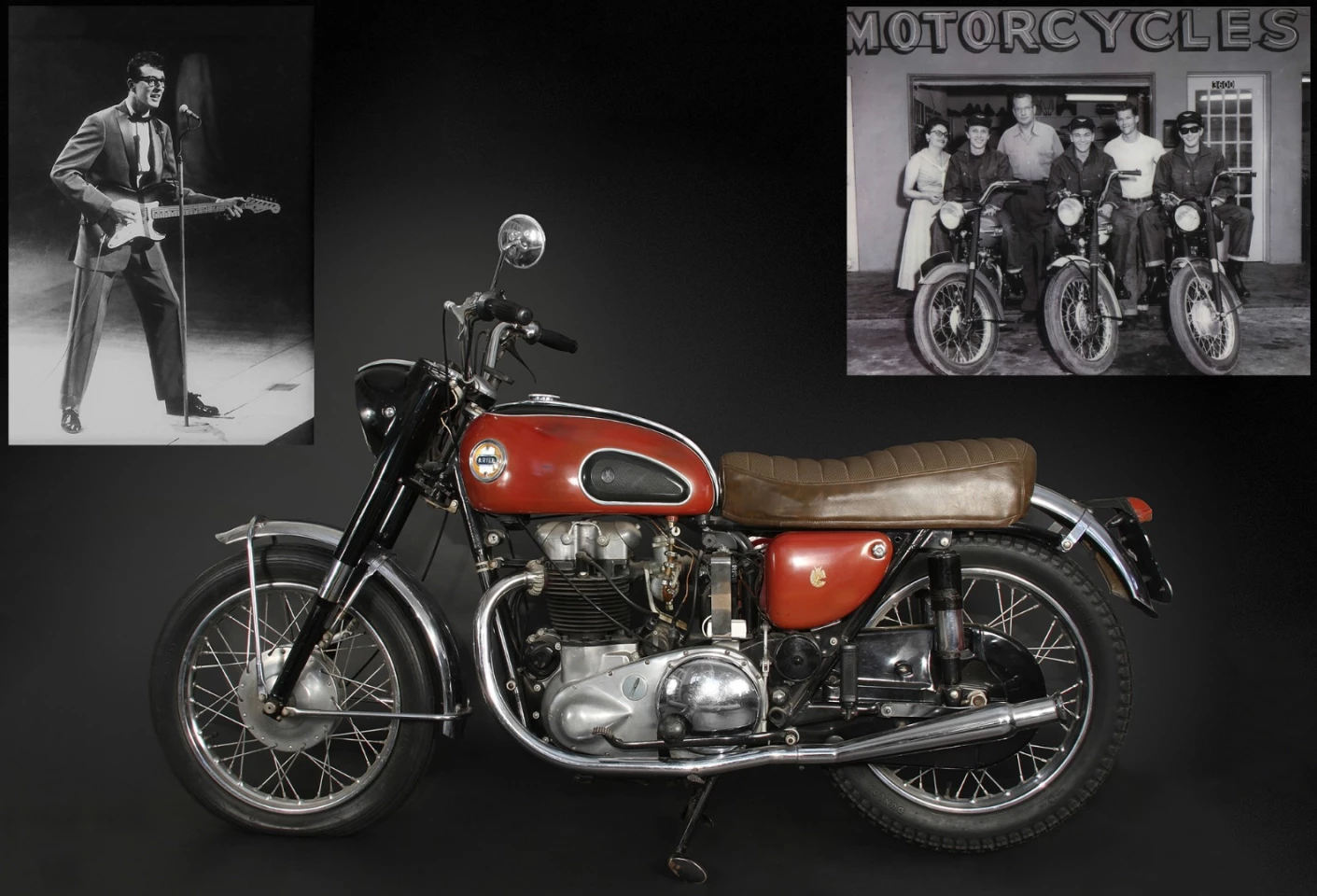
Though famous for only 17 months of his life (from the day his first hit That'll Be the Day topped the Billboard charts to his death in an air crash), Buddy Holly is widely recognized as one of the most profound influences in musical history. In 2004, Rolling Stone ranked Holly number 13 on its list of the 100 greatest artists of all time, The Beatles chose their name as an oblique reference to their respect for Holly's band (The Crickets) and Don McLean's "The Day the Music Died" begins with reference to the tragedy which took Holly's life.
Holly was a motorcyclist and when his 1958 Ariel Cyclone 650 went to auction in 2014, it had spent 30 years in the den of Holly's best friend, and another musical legend, Waylon Jennings. With such stellar provenance, the Cyclone fetched $450,000, becoming one of the 10 most expensive motorcycles ever sold at auction.
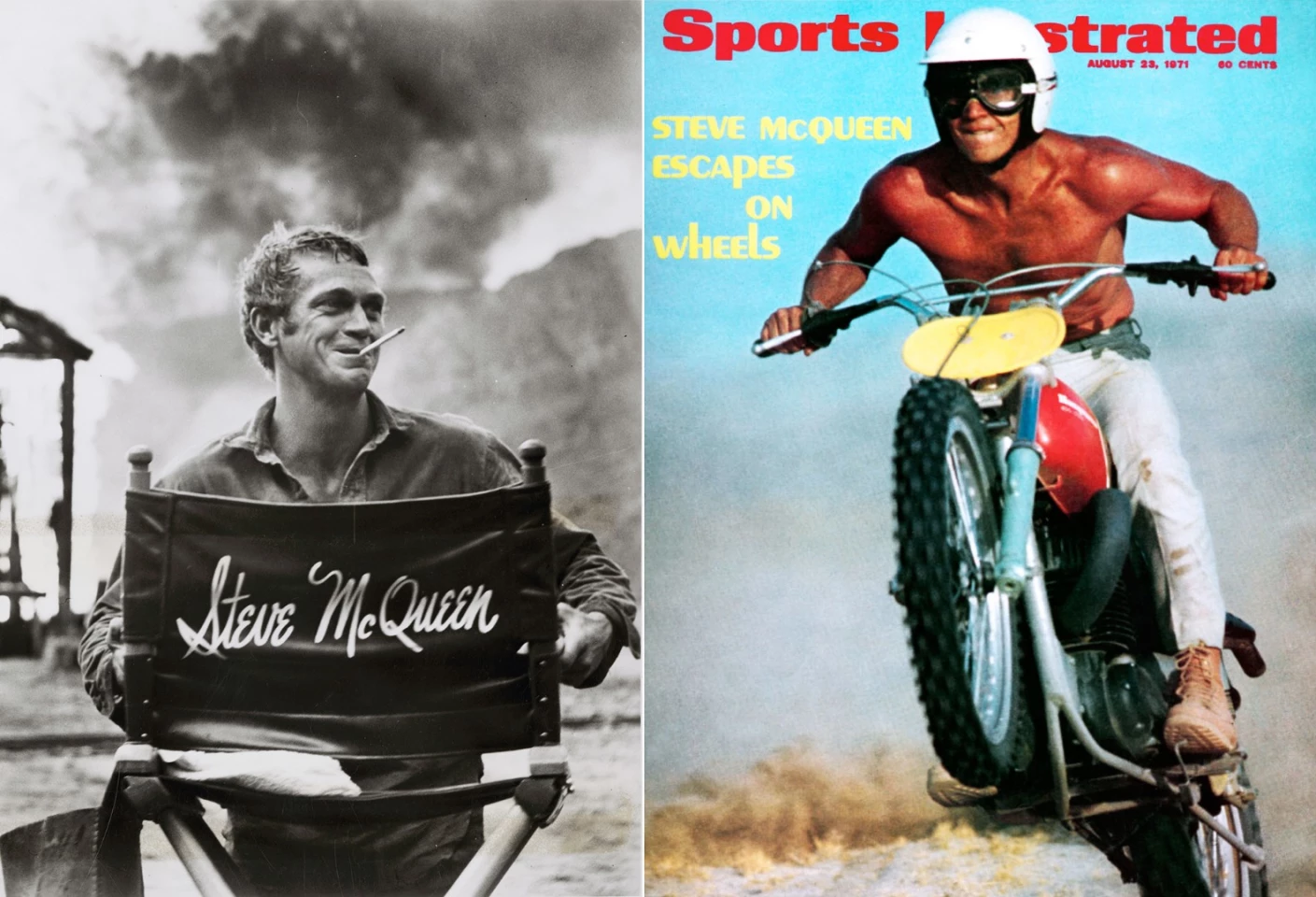
Steve McQueen and the Husqvarna 400 Cross on Sports illustrated and On Any Sunday
Finally, the image of Steve McQueen riding shirtless on a Husqvarna 400 Cross on the front cover of the world's highest circulation sports magazine, Sports Illustrated, remains one of the most recognizable motorcycle images of all time.
At the time of publication (cover date August 23, 1971), McQueen was the highest paid actor in the world, and Sports Illustrated was selling over two million copies a week.
It is not known which bike McQueen rode in that shot, and there are no claims that the bike being auctioned last week was that bike, but there's a reasonable chance it was this bike, because the other Husqvarna 400 Cross bikes (he purchased Husqvarna 400 Cross #MI-3845 on August 26, 1971 and Husqvarna 400 Cross #MI-4666 on February 22, 1972) we can trace to McQueen were purchased after the Sports Illustrated cover was published.
That does not constitute proof, and Bonhams specifically asked us to be clear that there is no claim that this bike is the Sports Illustrated cover bike. What's more, Steve owned a 360 Husqvarna as far back as 1968, and if you can tell a Husqvarna 360 Cross from a 400 Cross, please feel free to share your thoughts in the comments section.
As two previous owners of this bike have shown though, "where there's a will, there's a way" and whenever you put together an article such as this, where you attempt to piece together history from just a few decades ago, you gain immense appreciation for the archaeologists who deal in millennia, not decades. That said, it is IMHO, very likely that the bike sold for $230,000 by Bonhams is the bike on the Sports Illustrated cover and a bit of due diligence from the next owner might further enhance the bike's value.
The $230,000 Husqvarna
Given all of the above, Steve McQueen's 1970 Husqvarna 400 Cross could be viewed as a steal at $230,500. Other iconic motorcycles have sold for much more.
